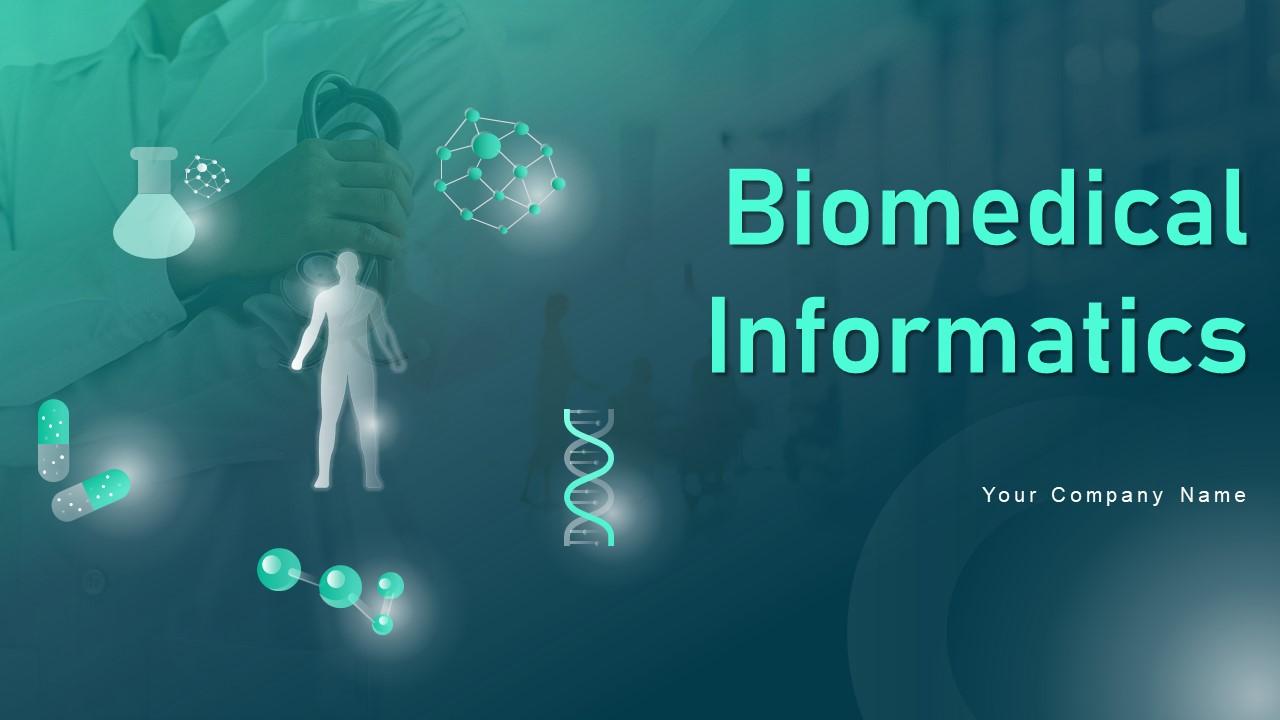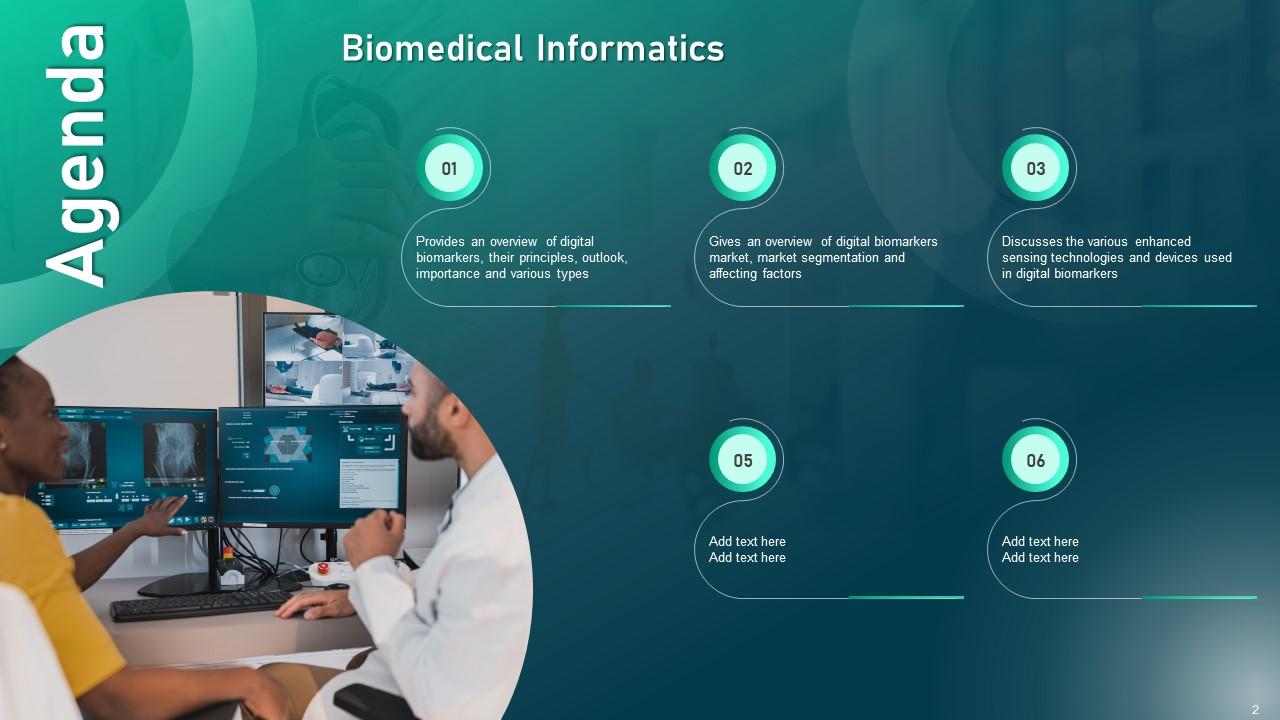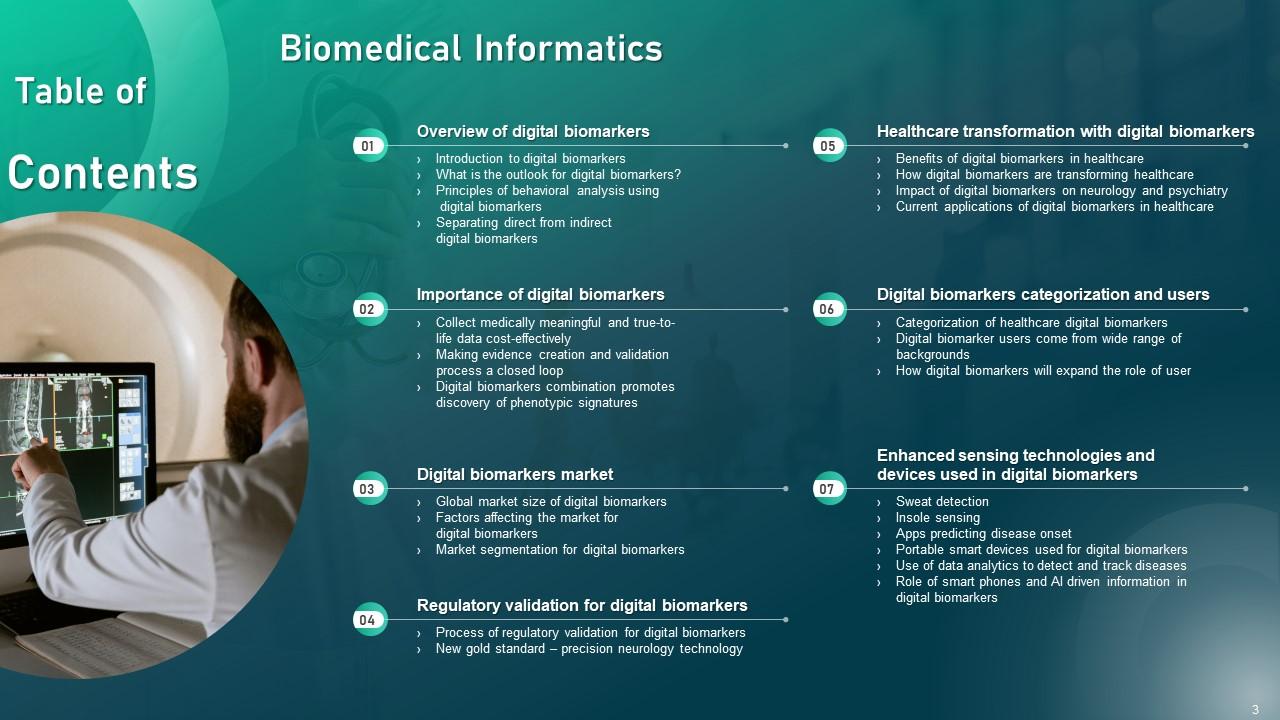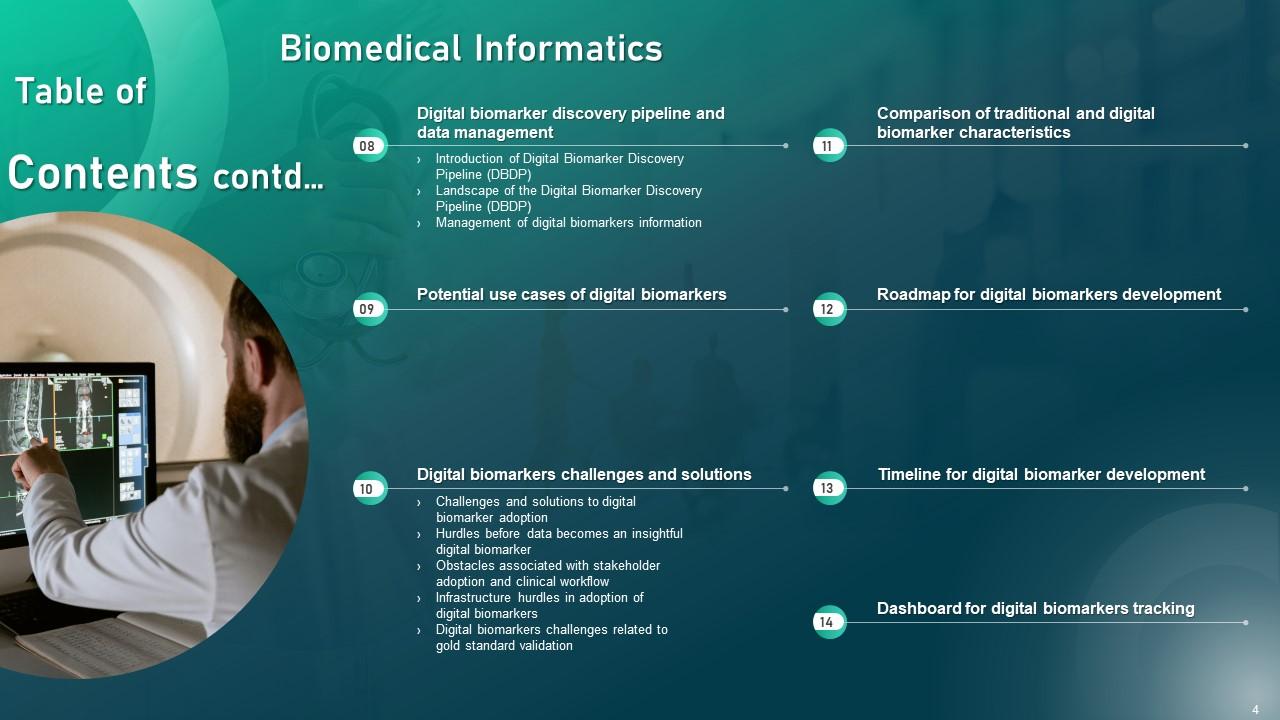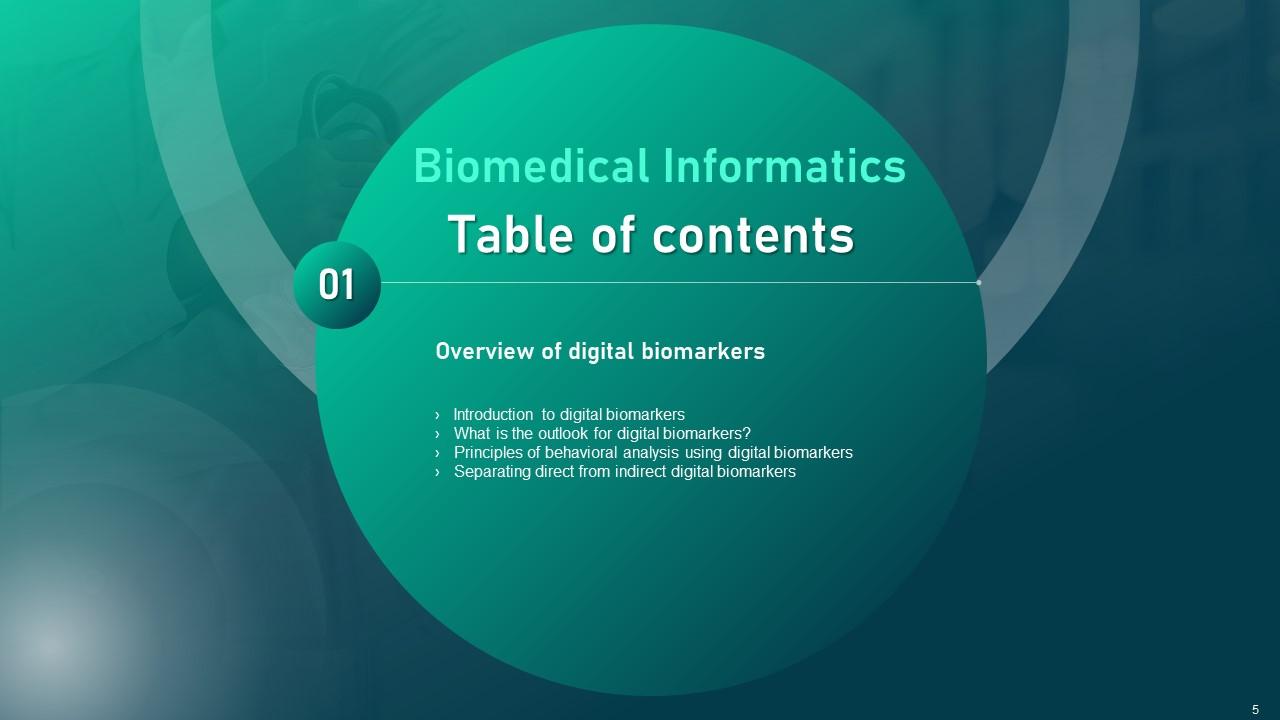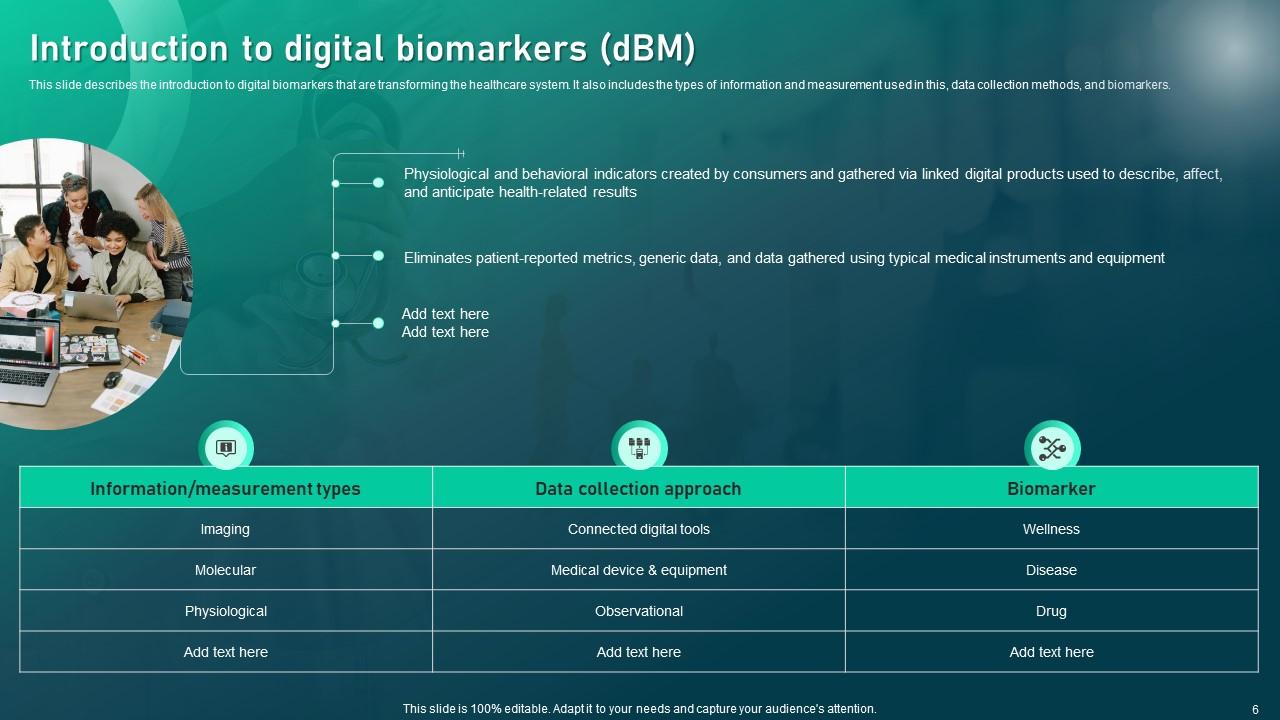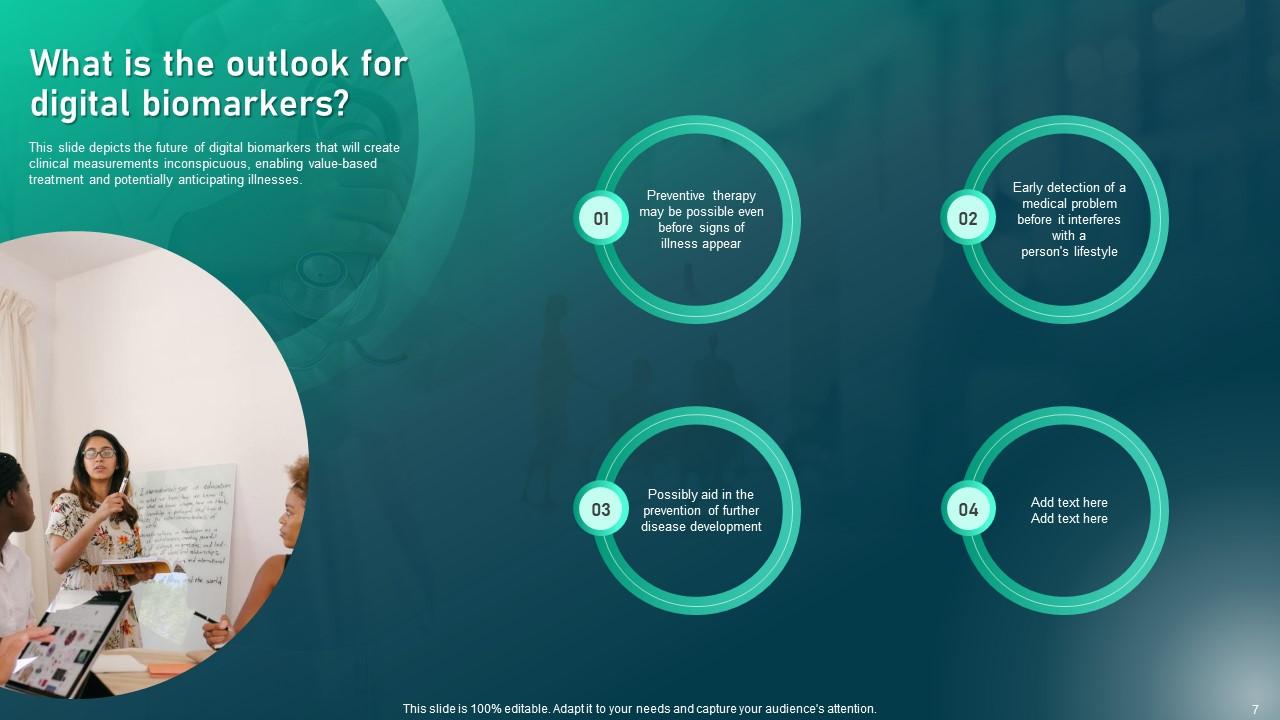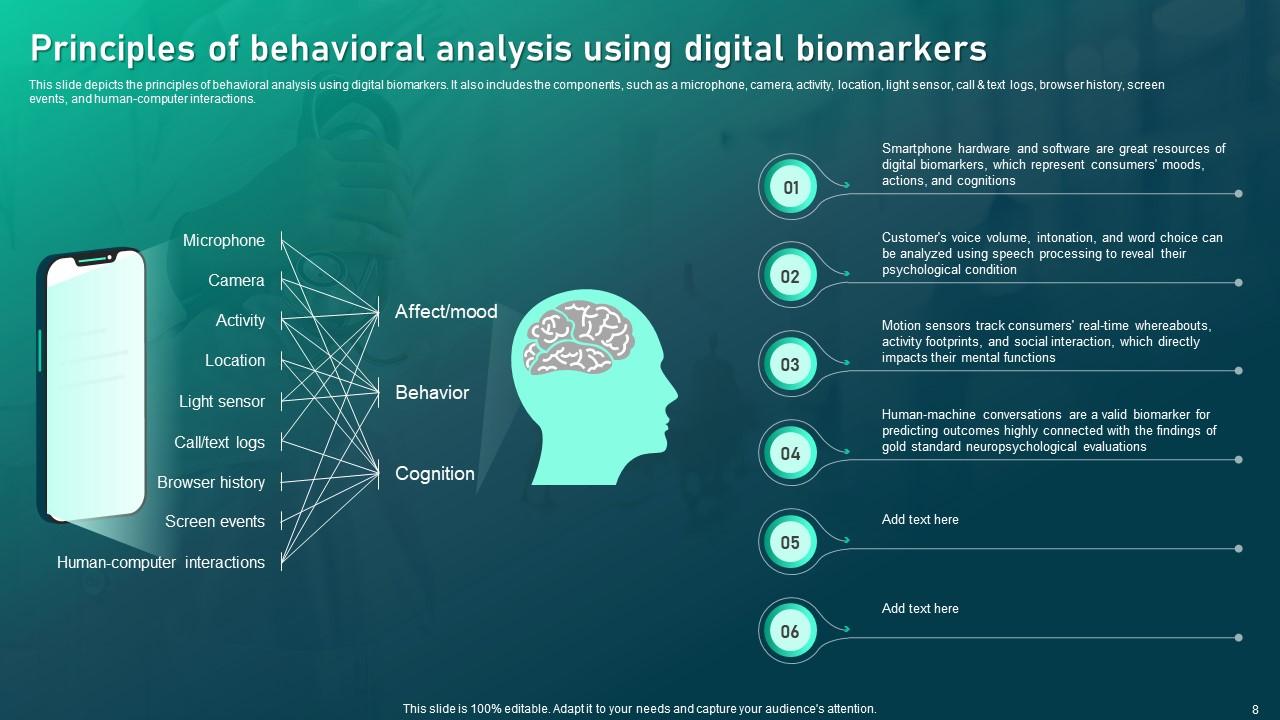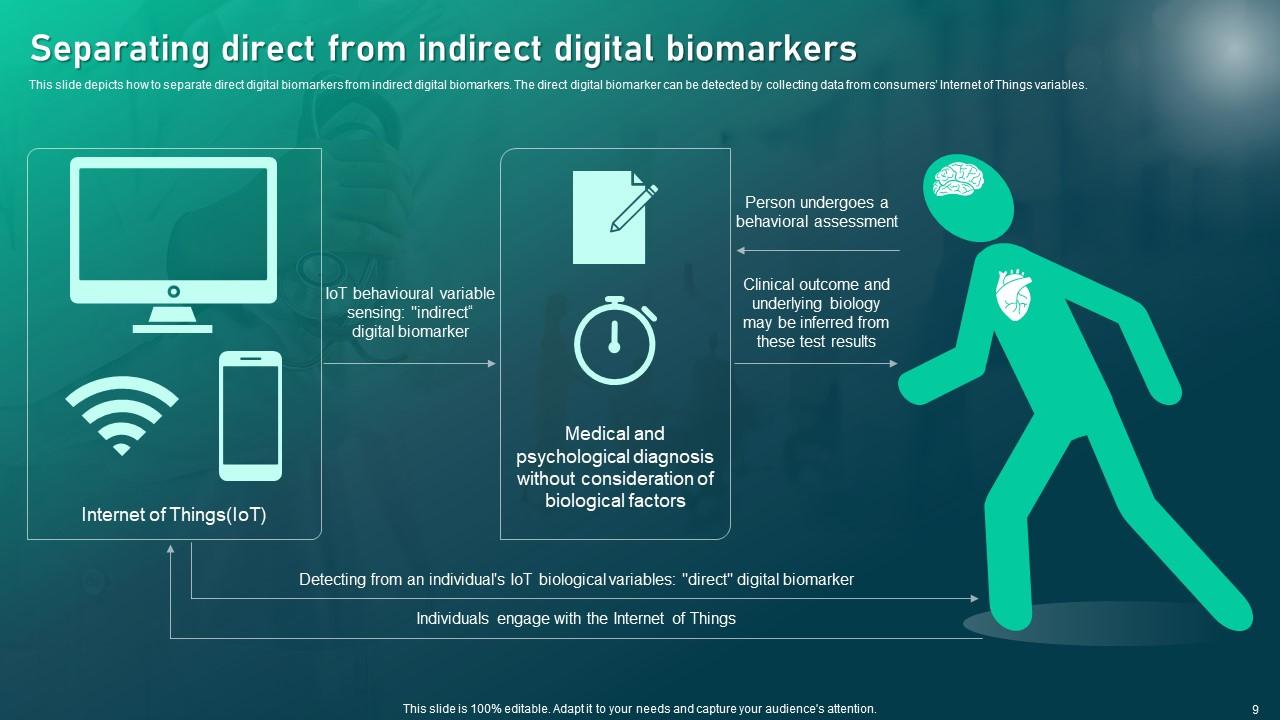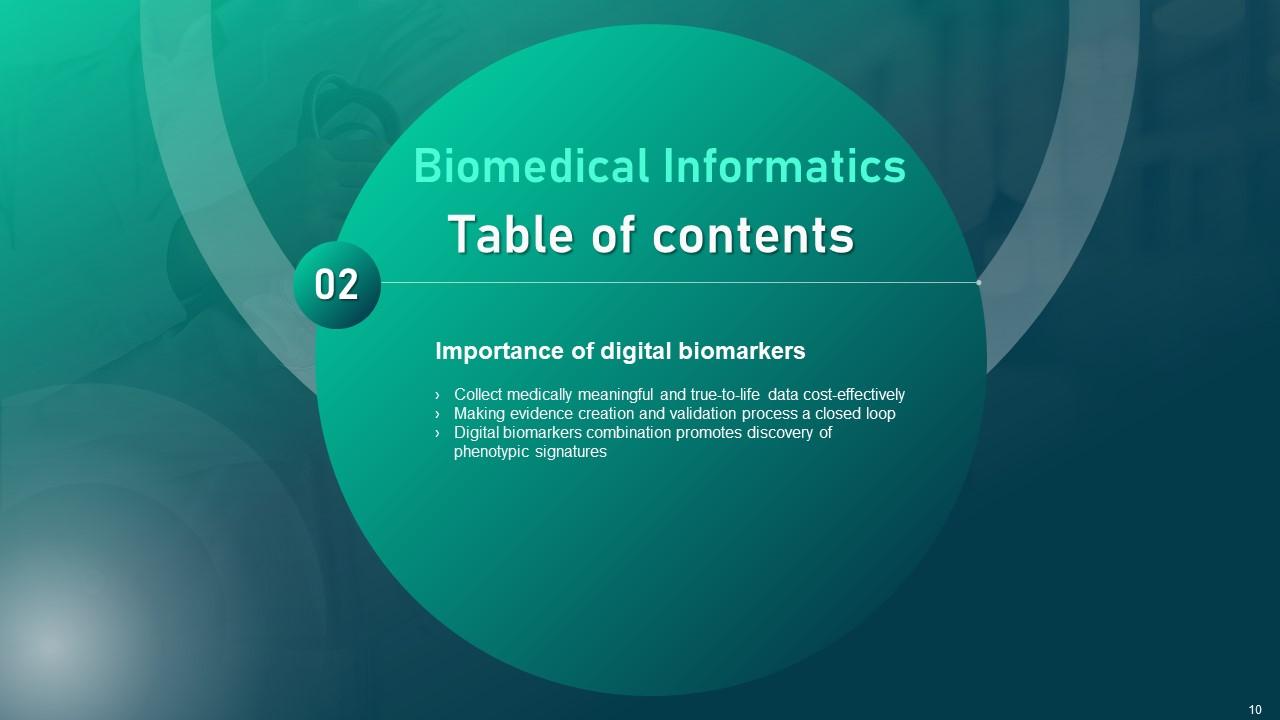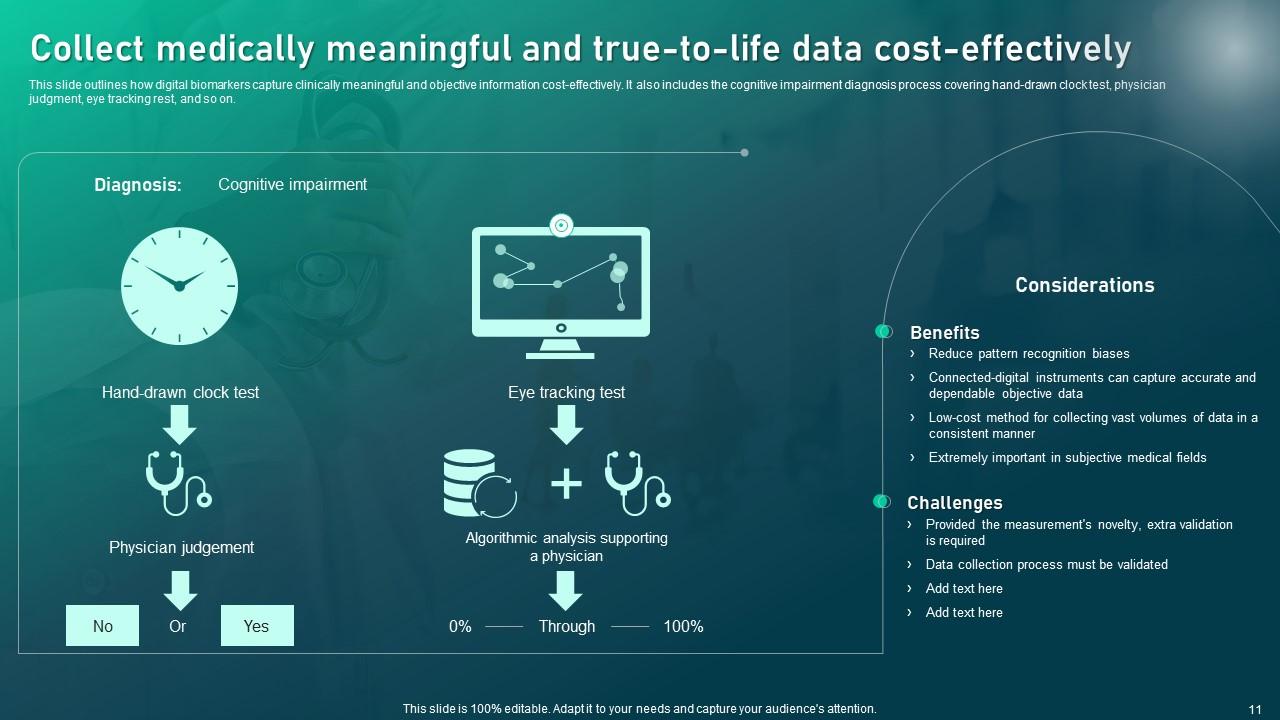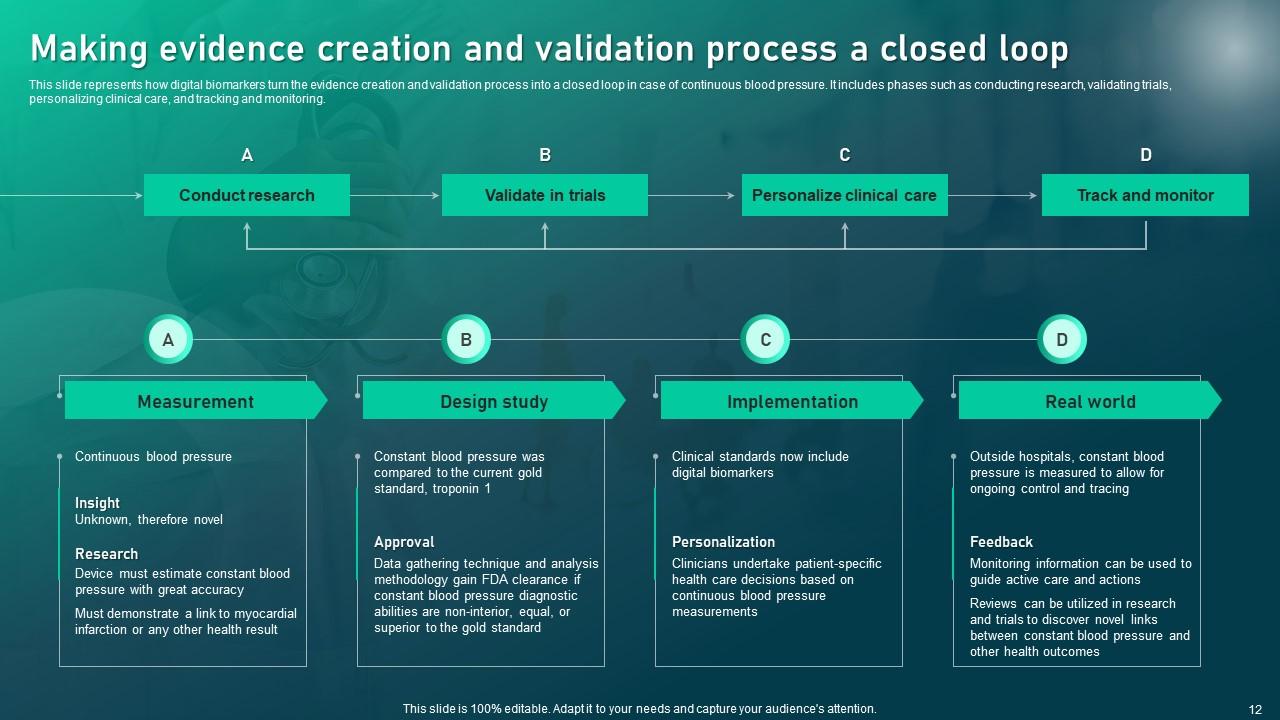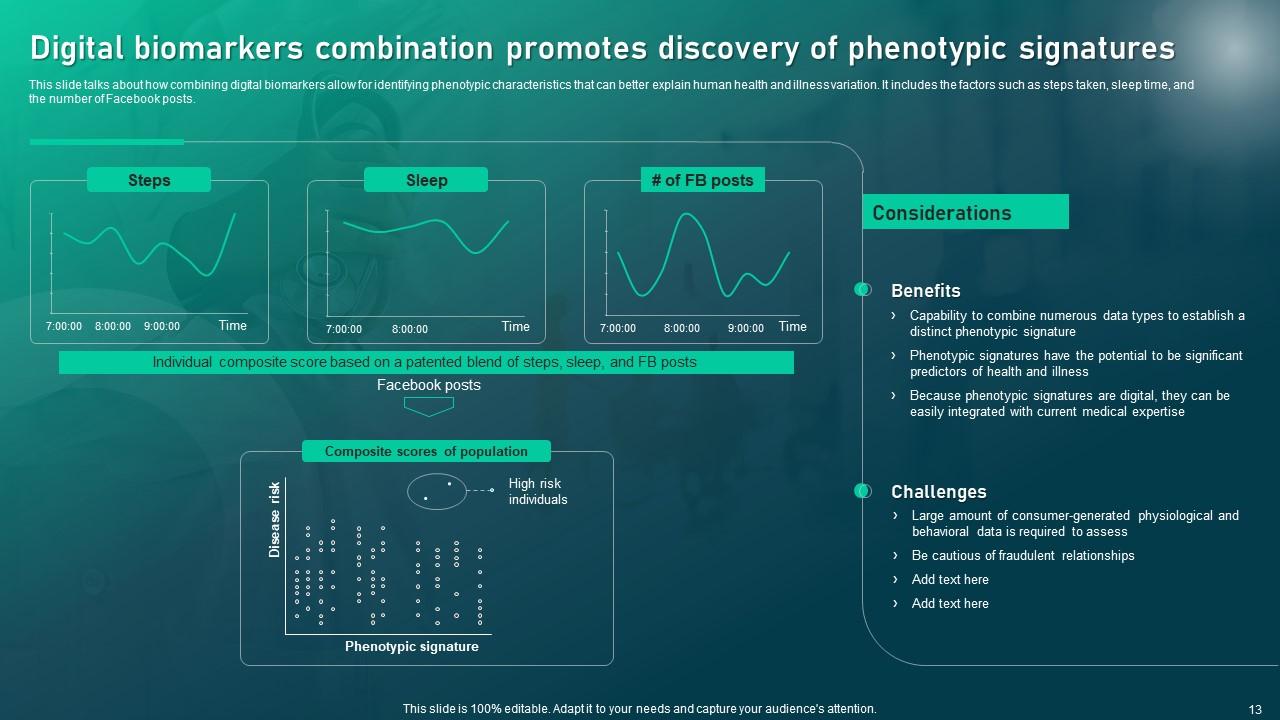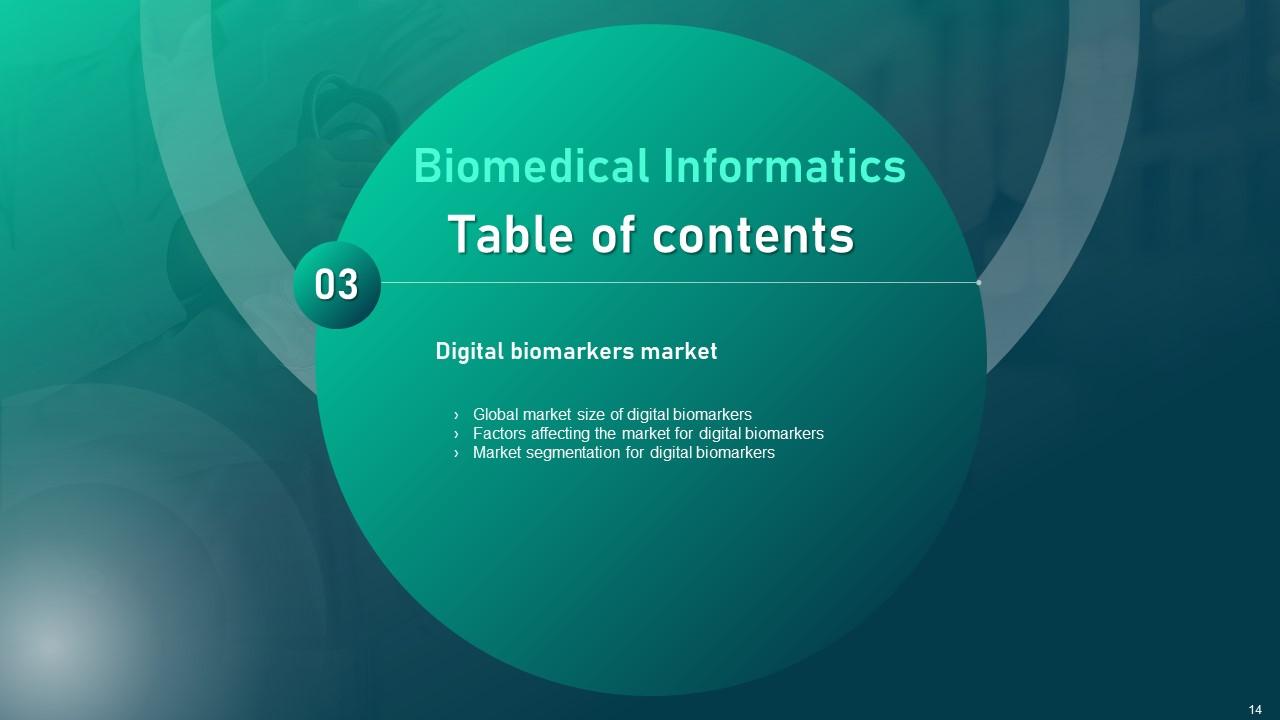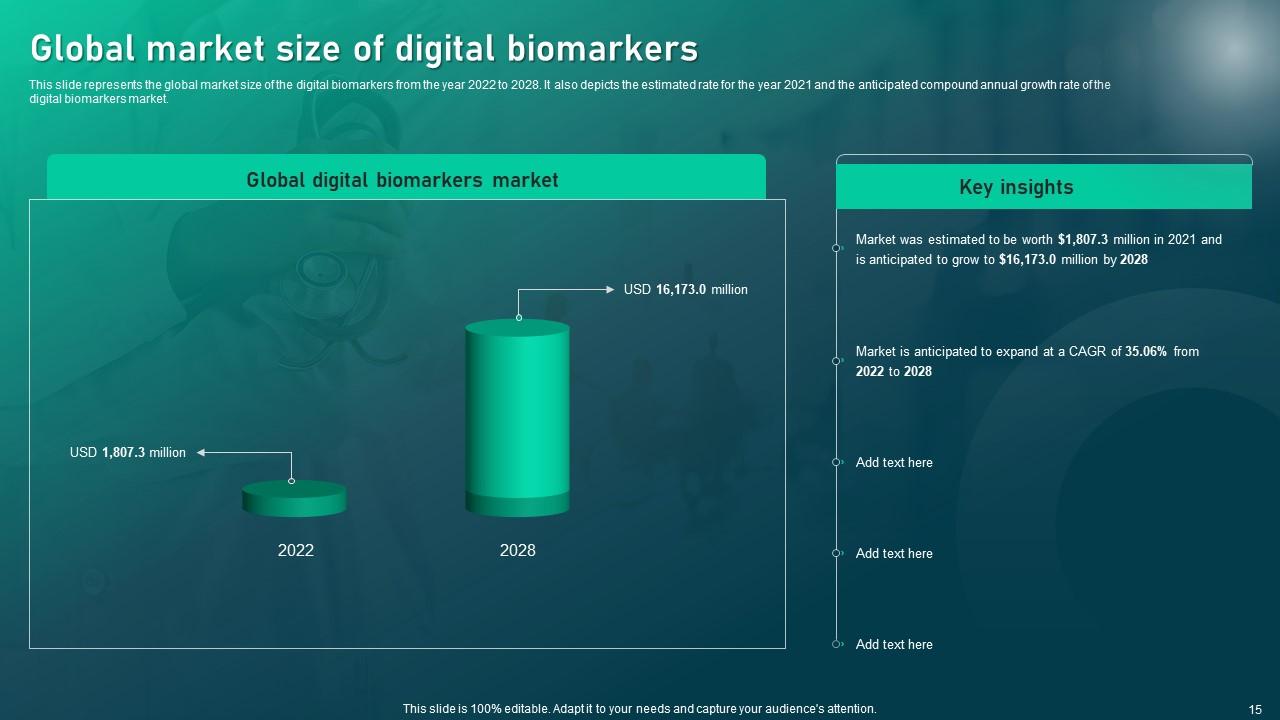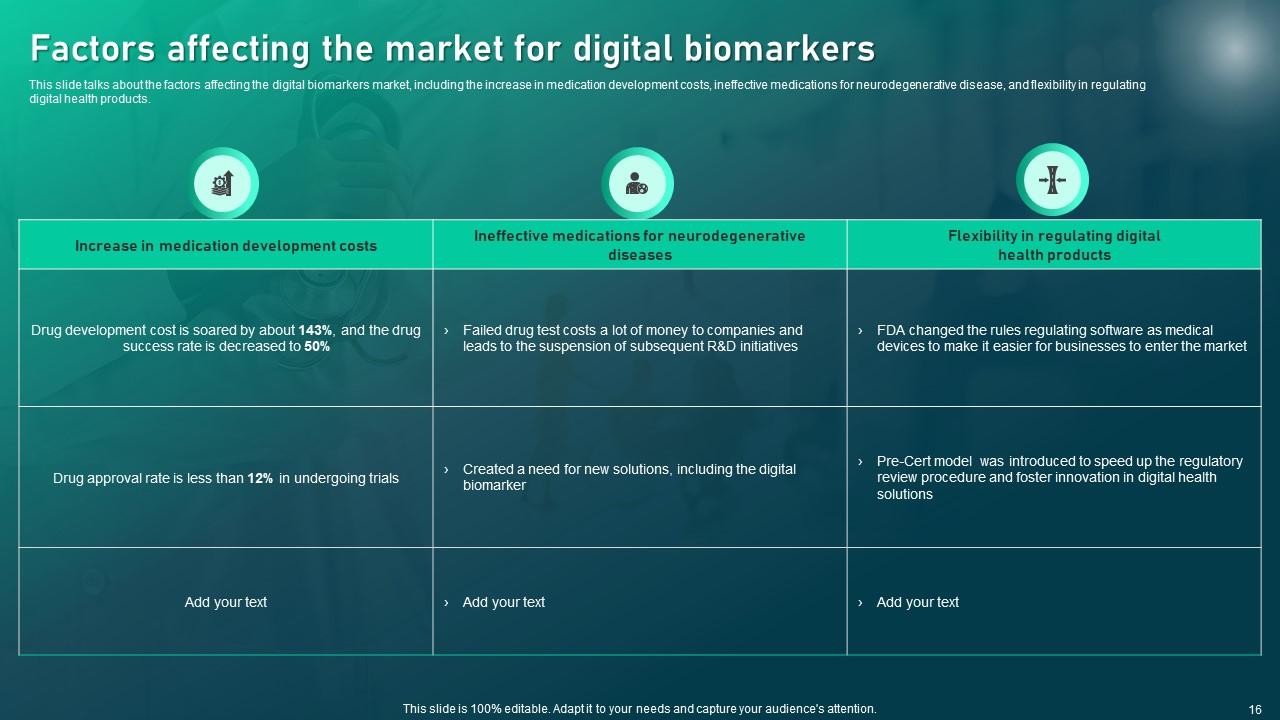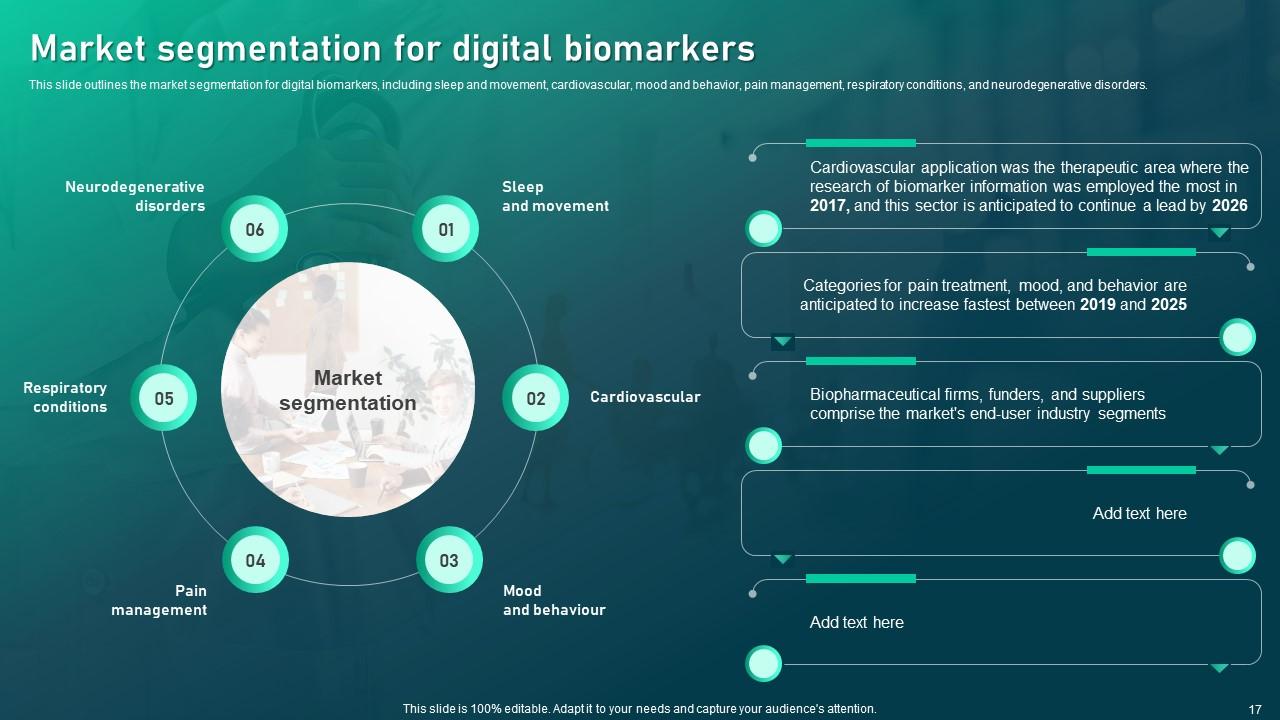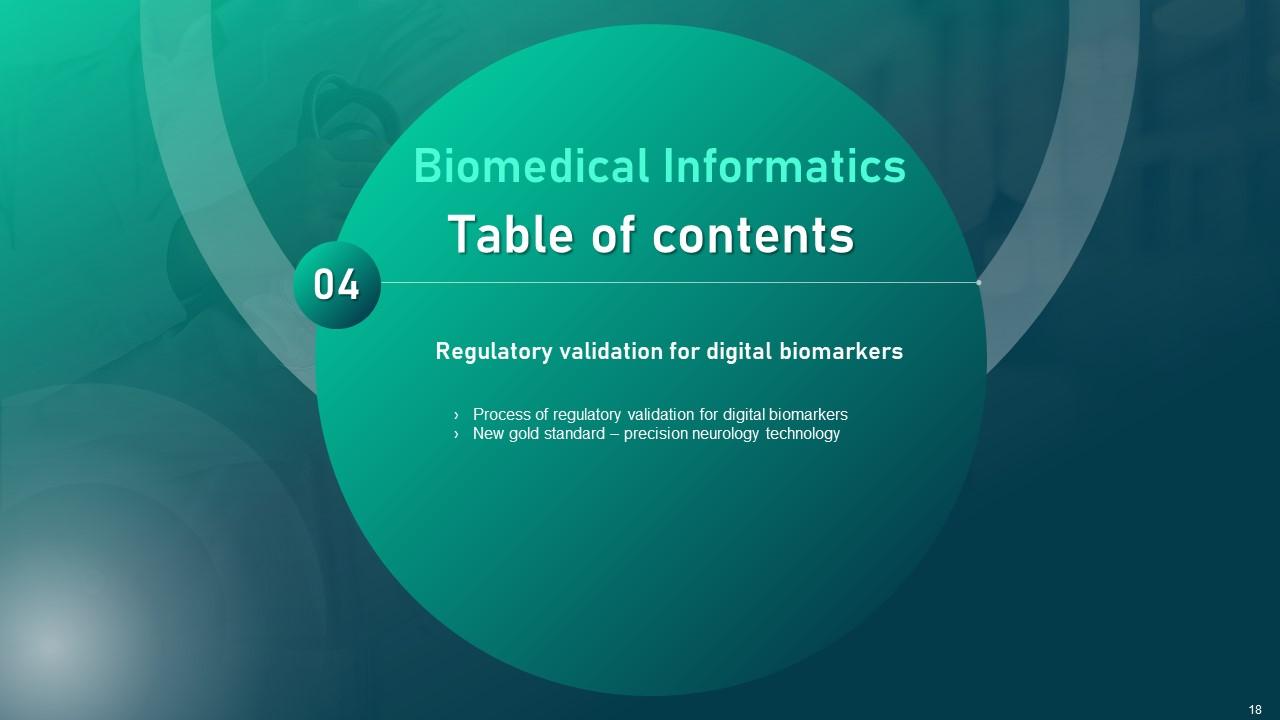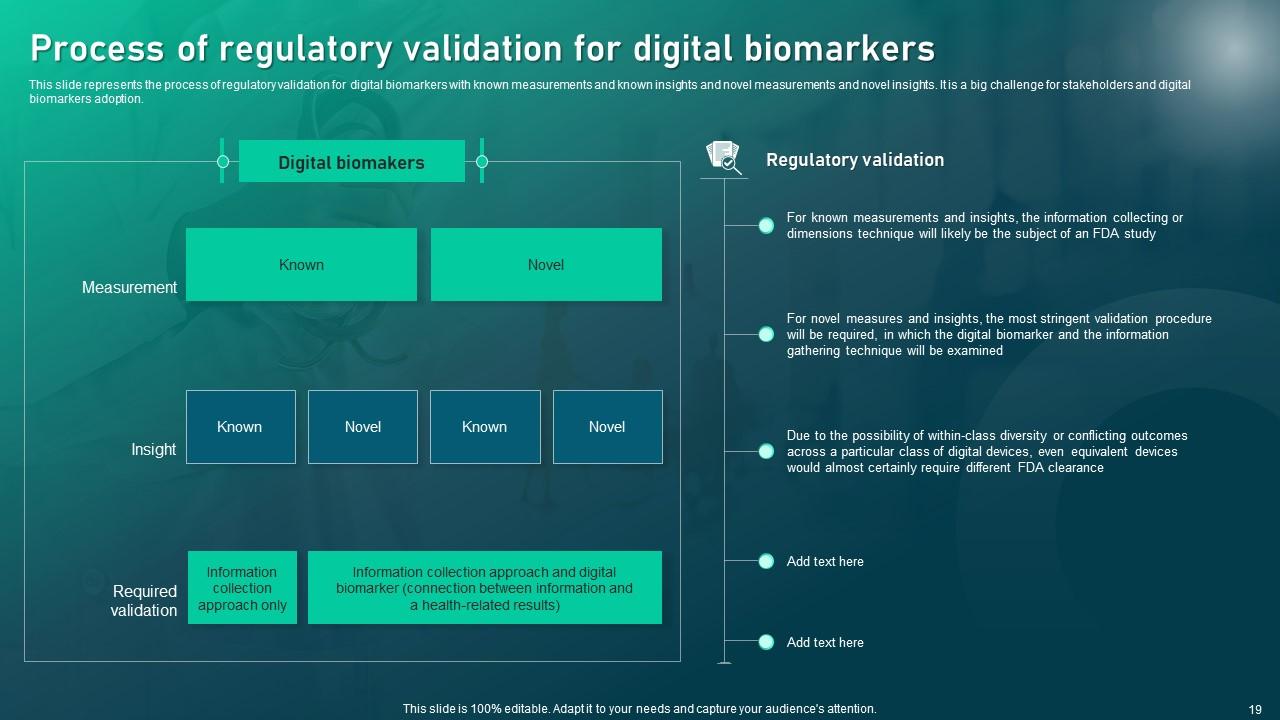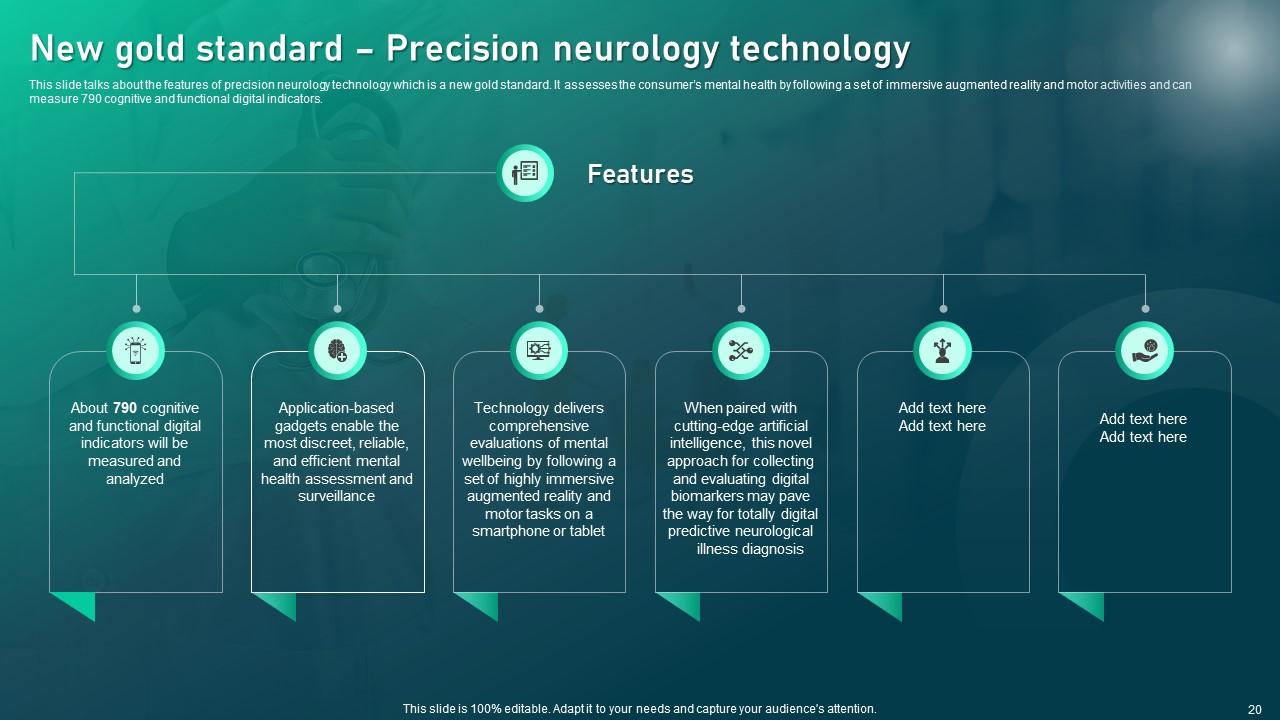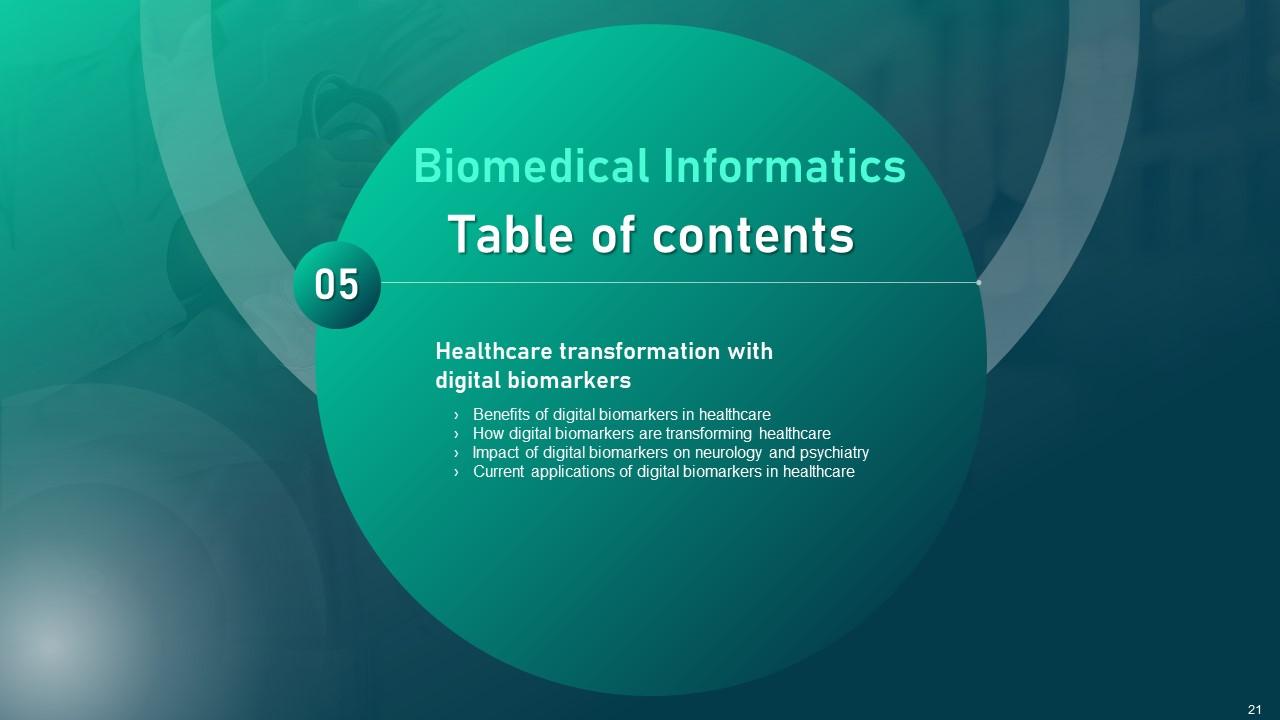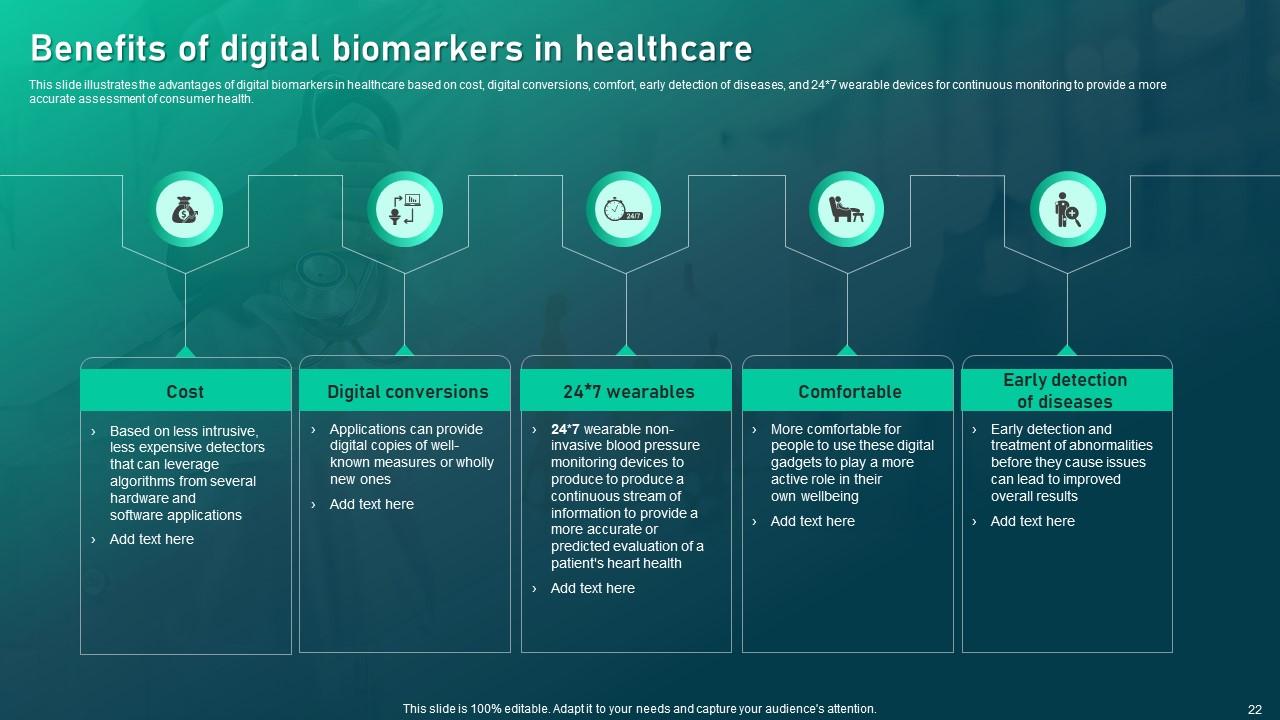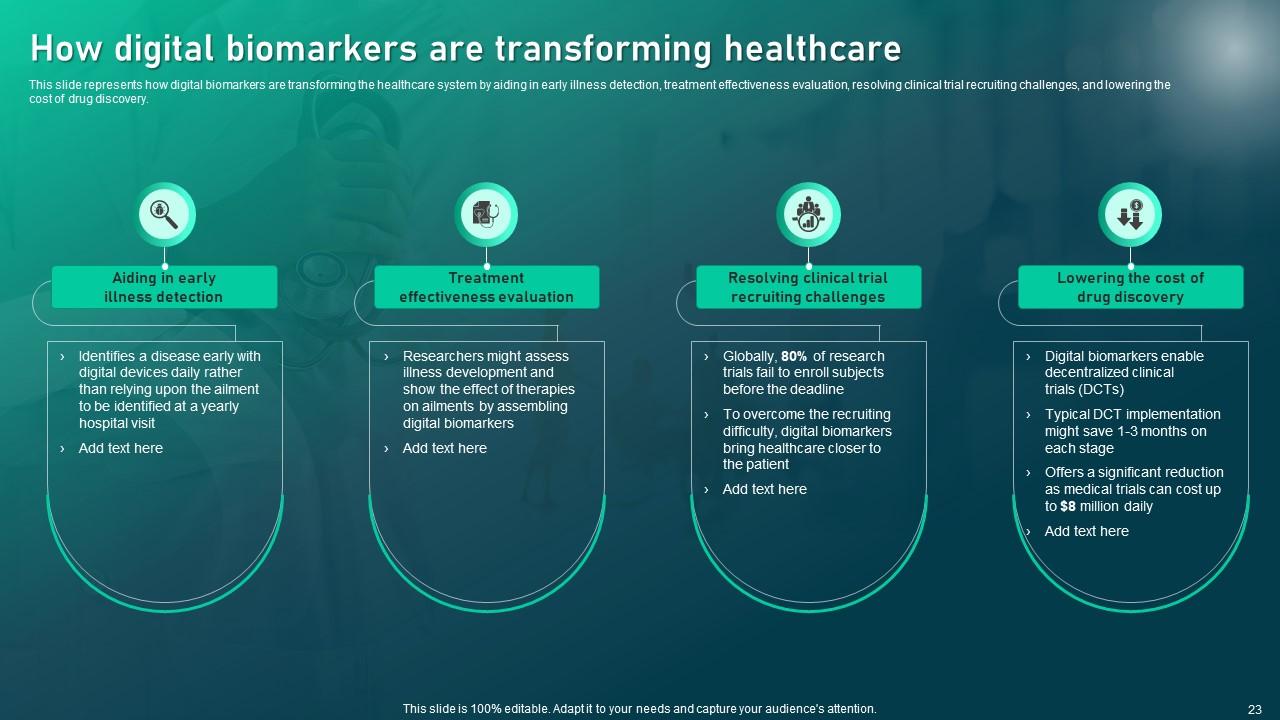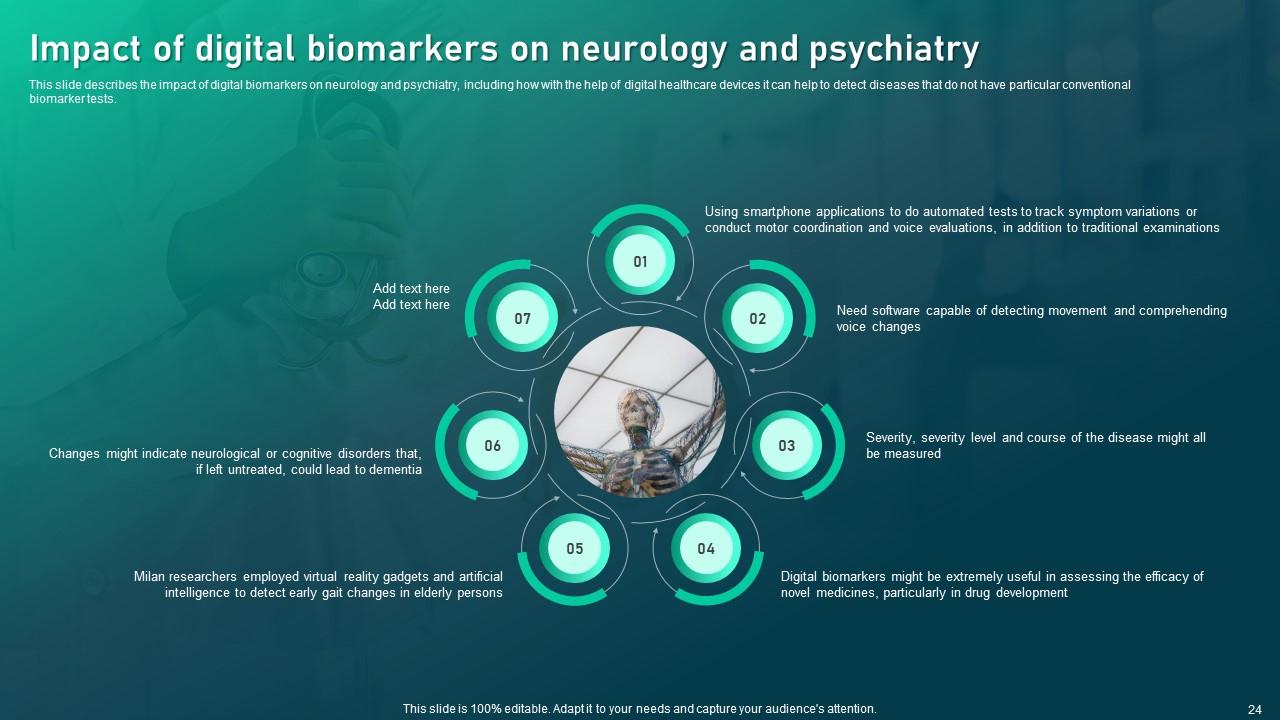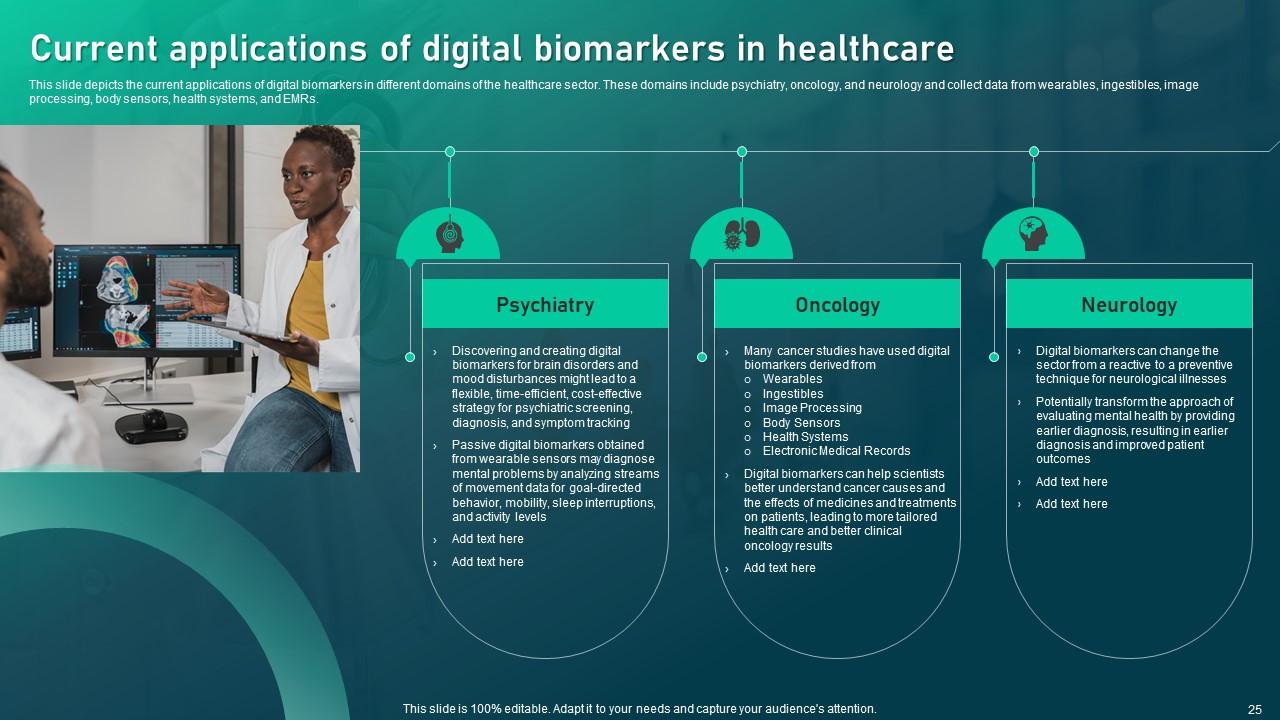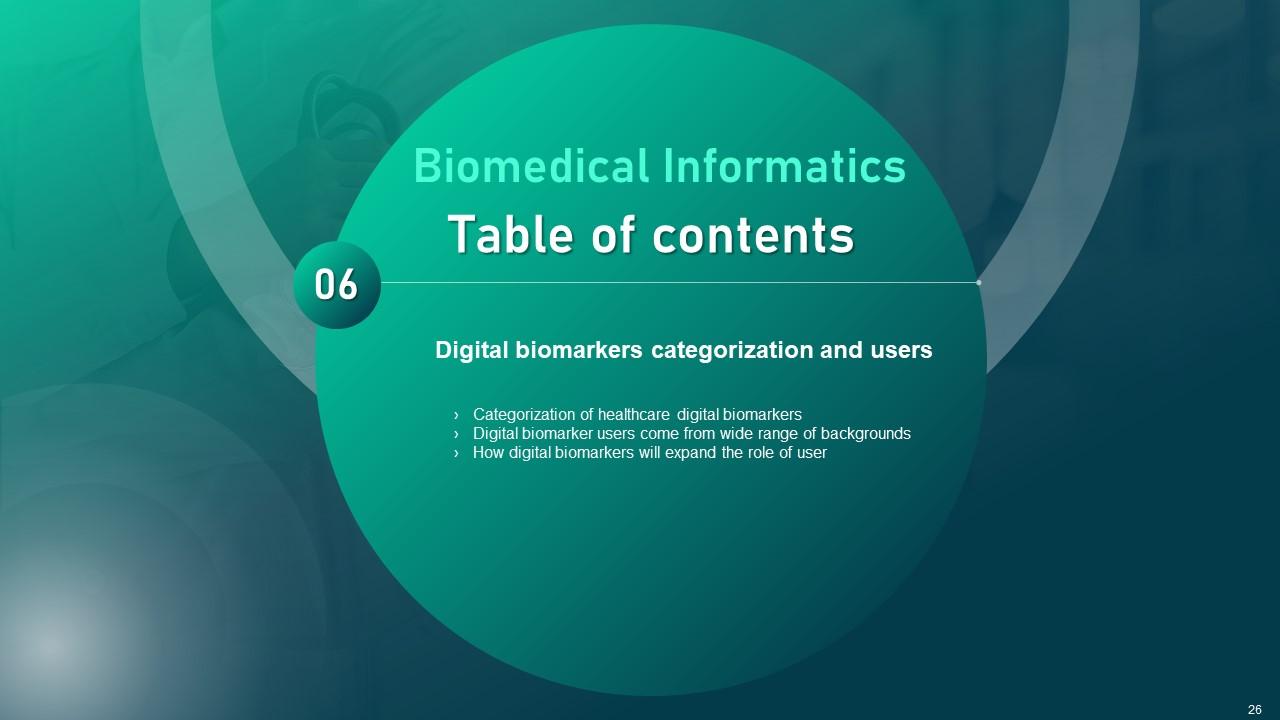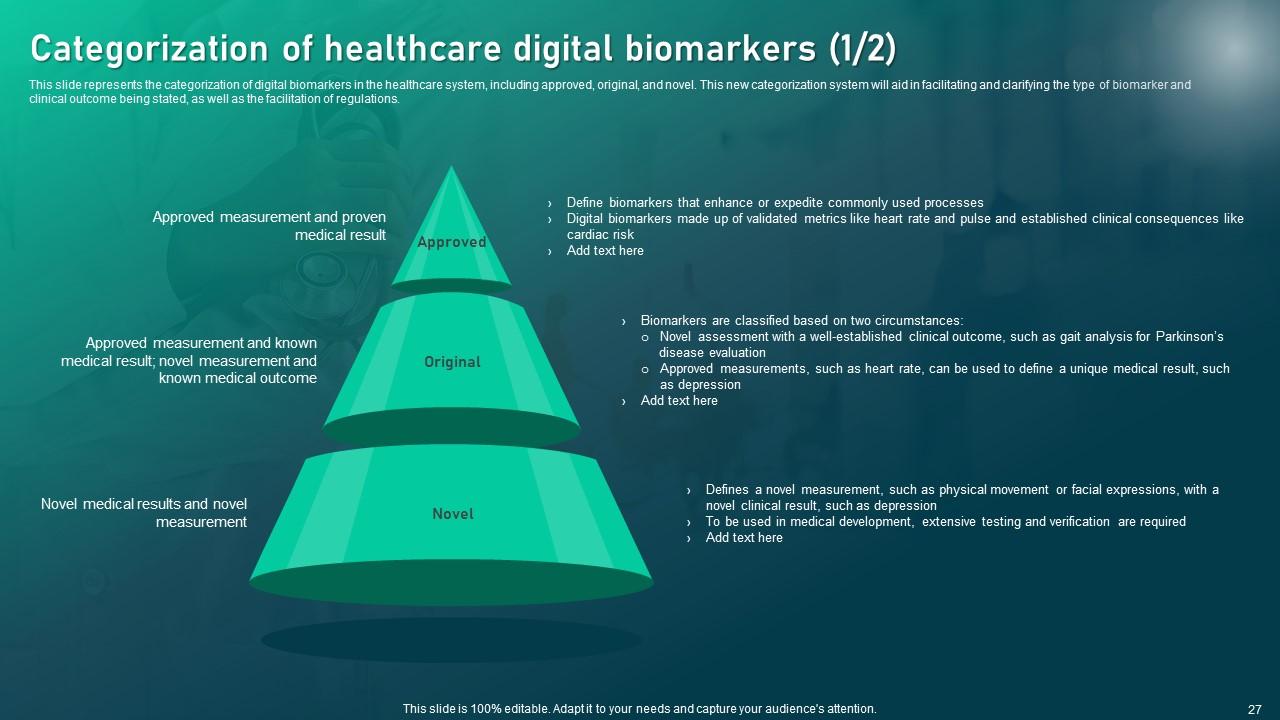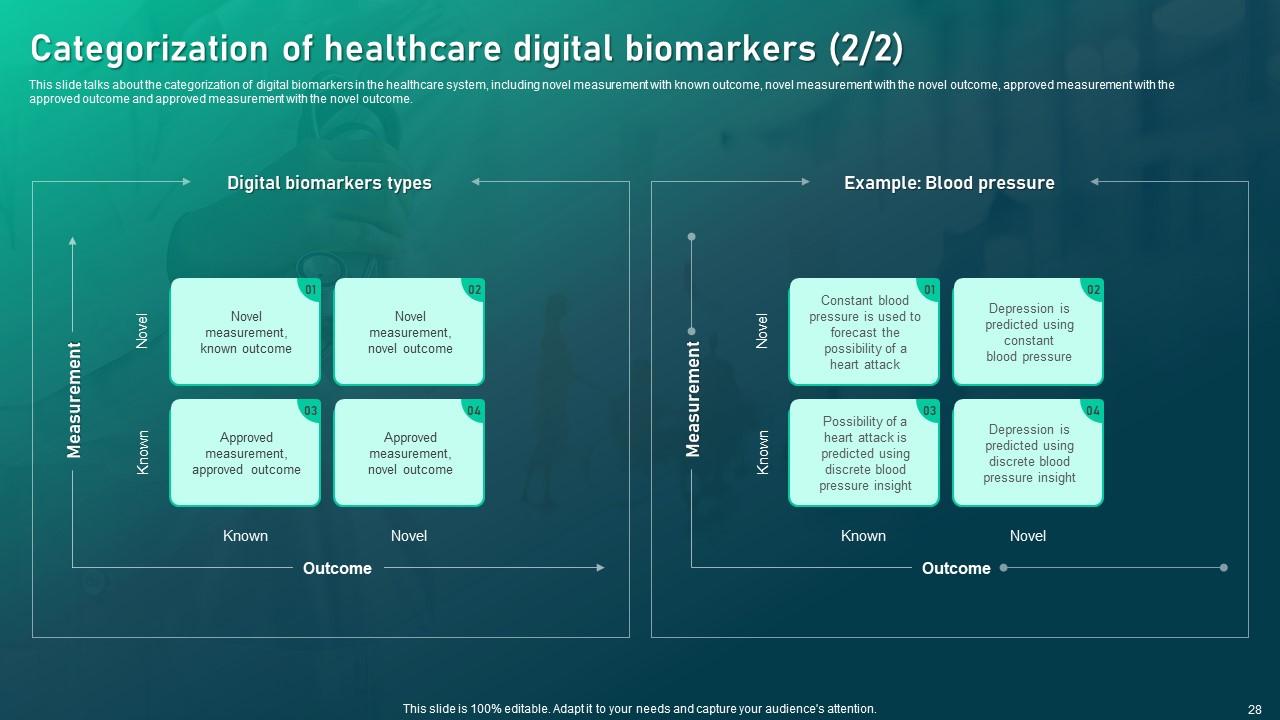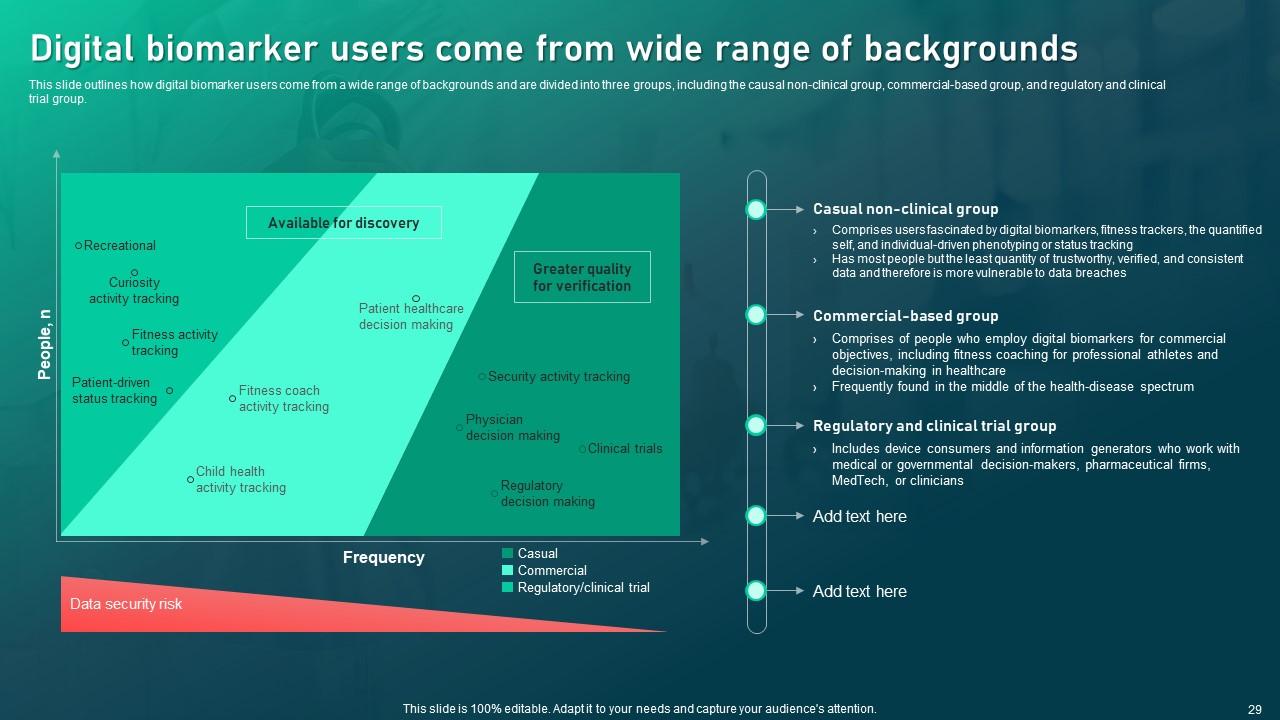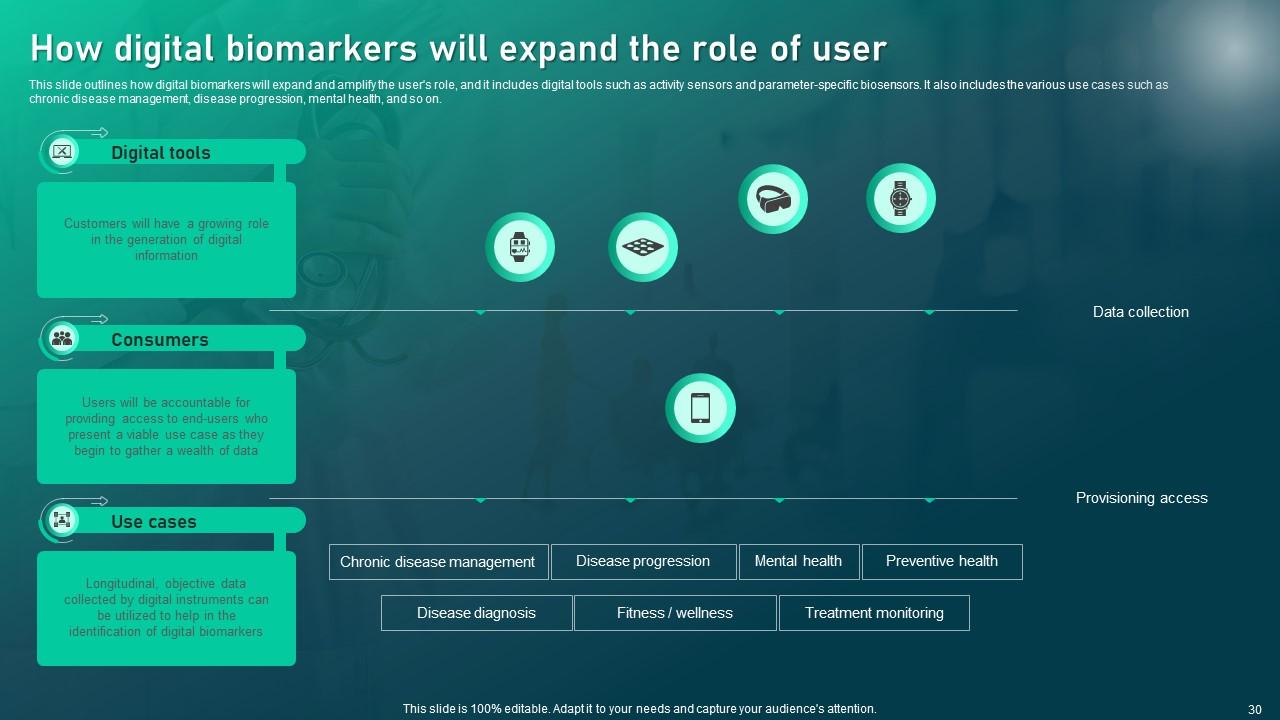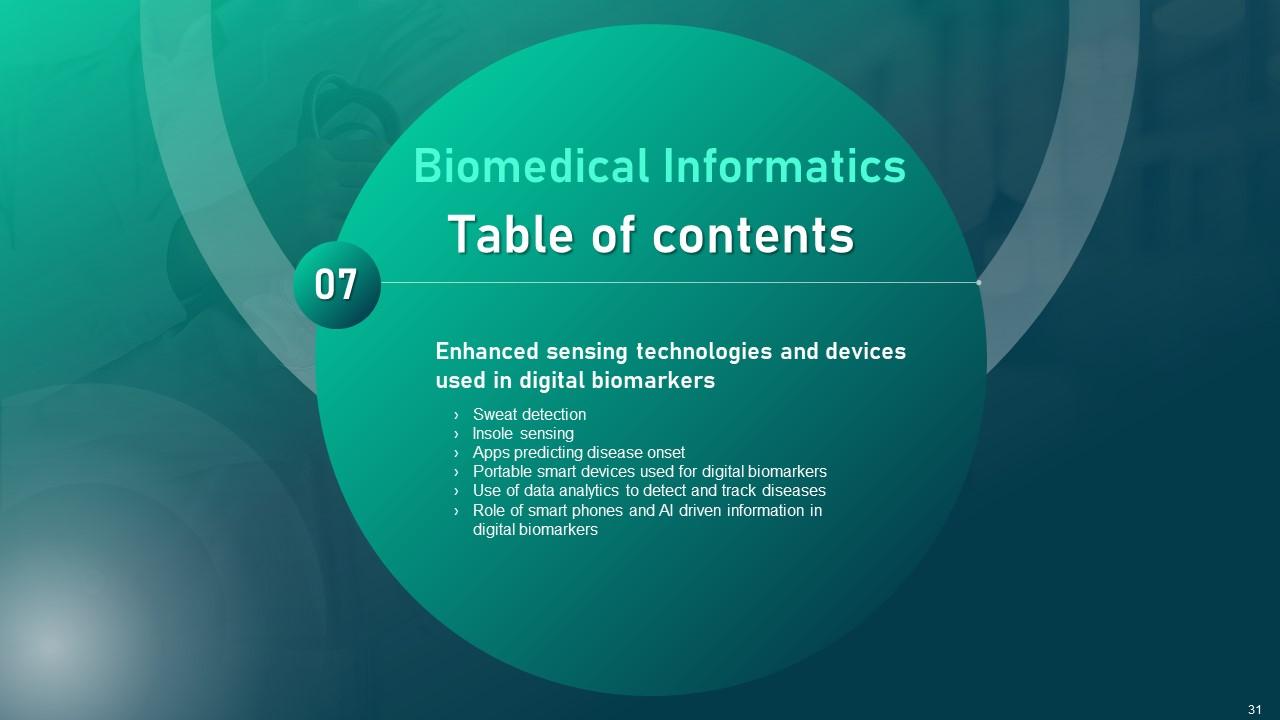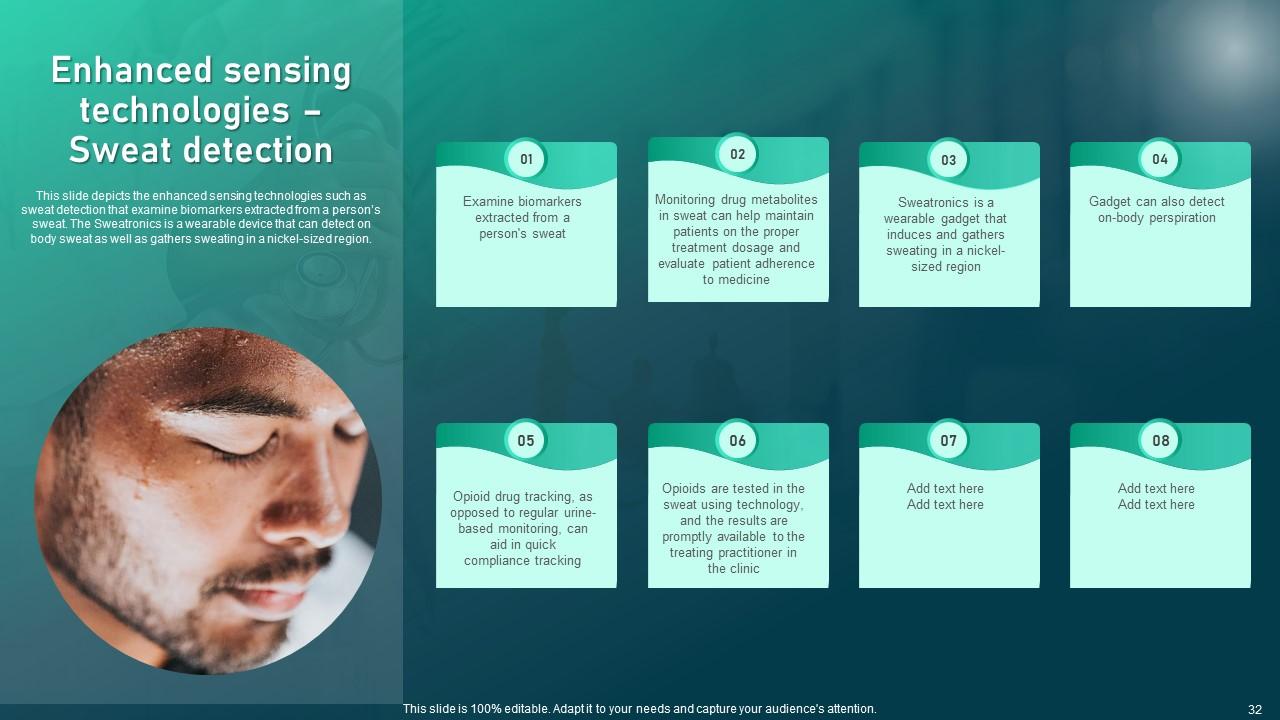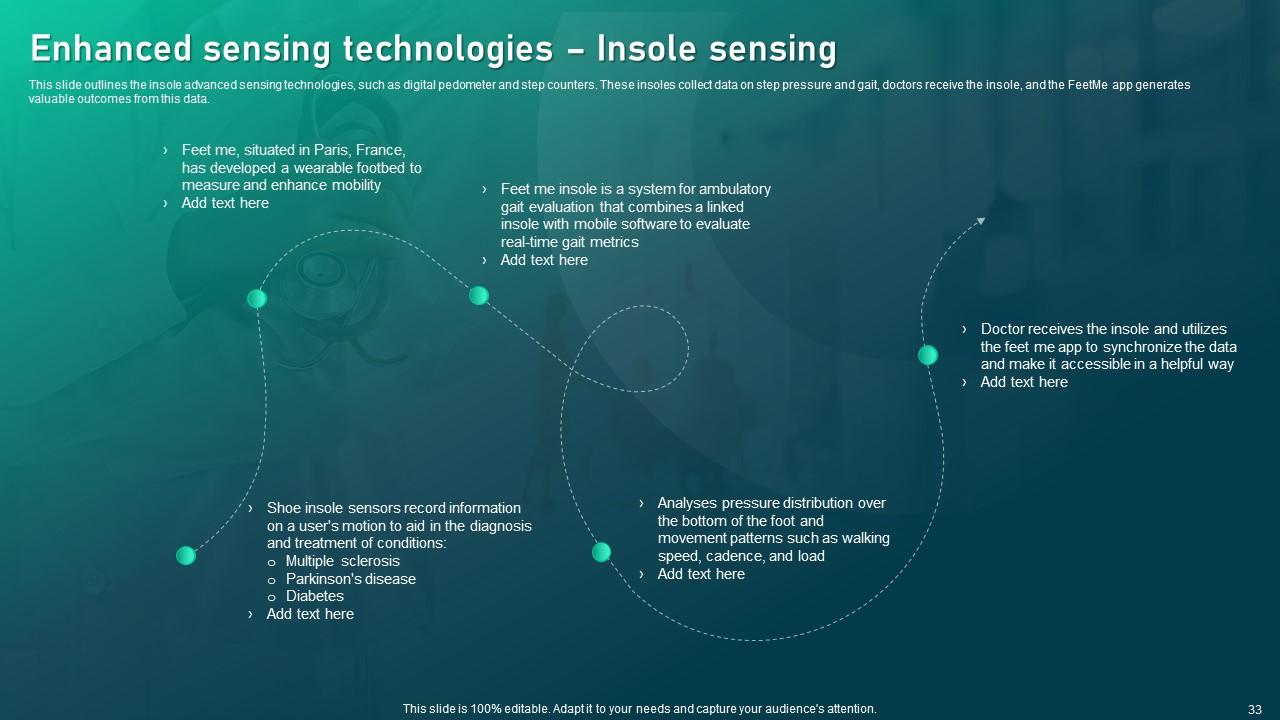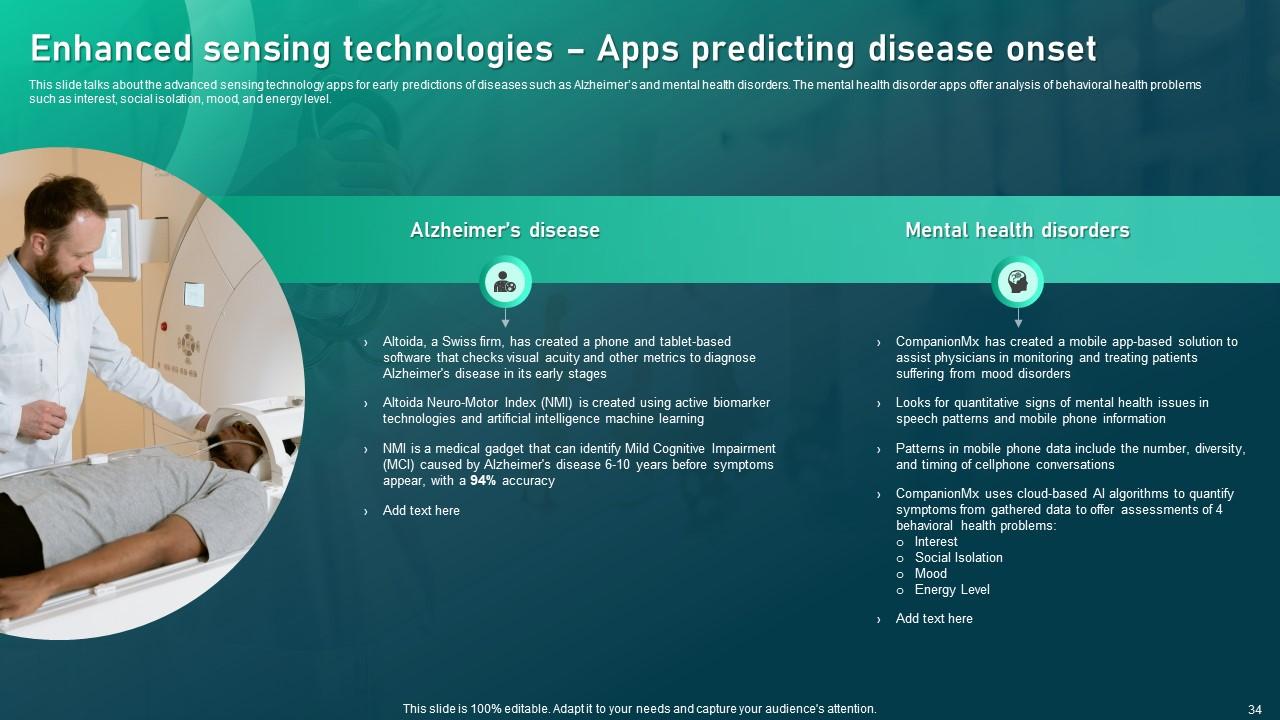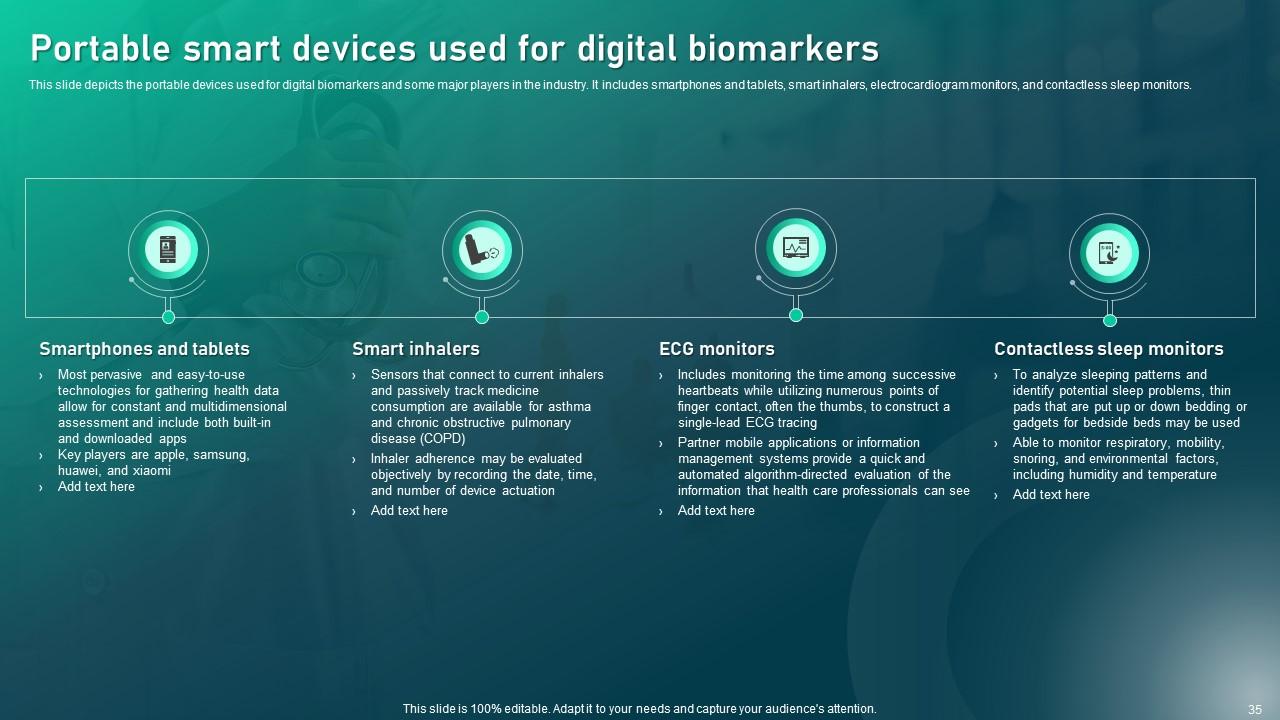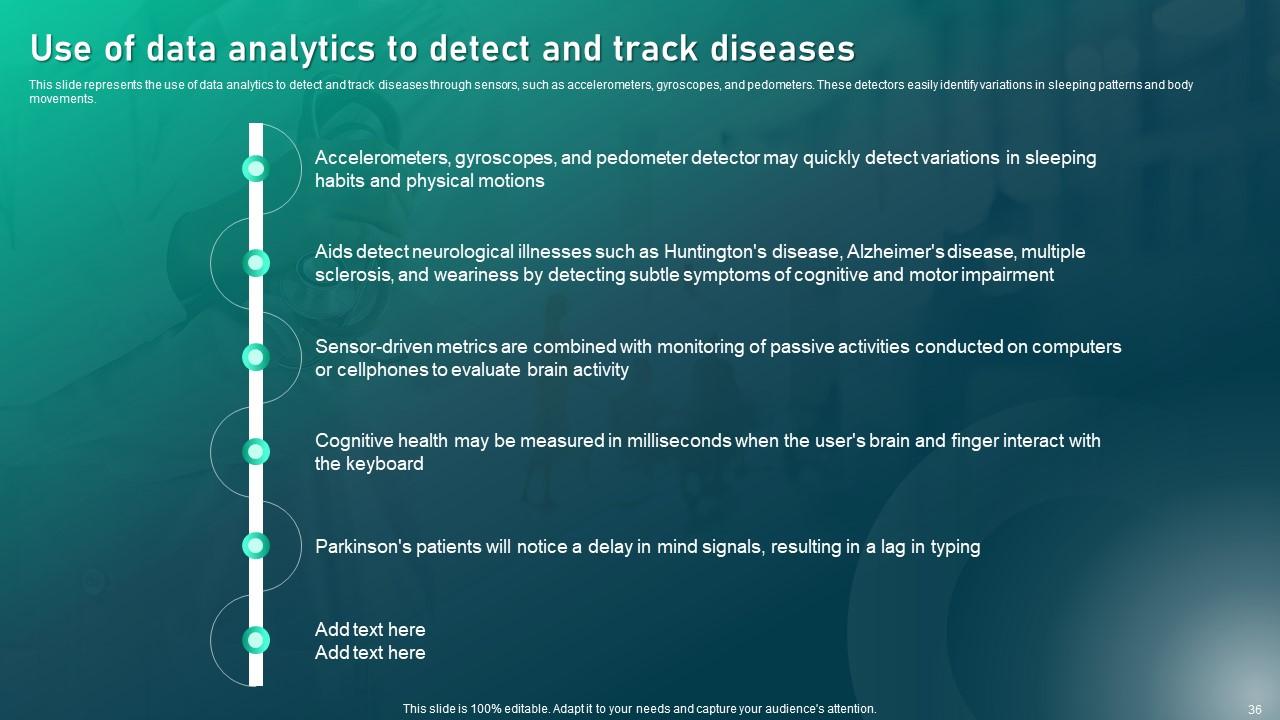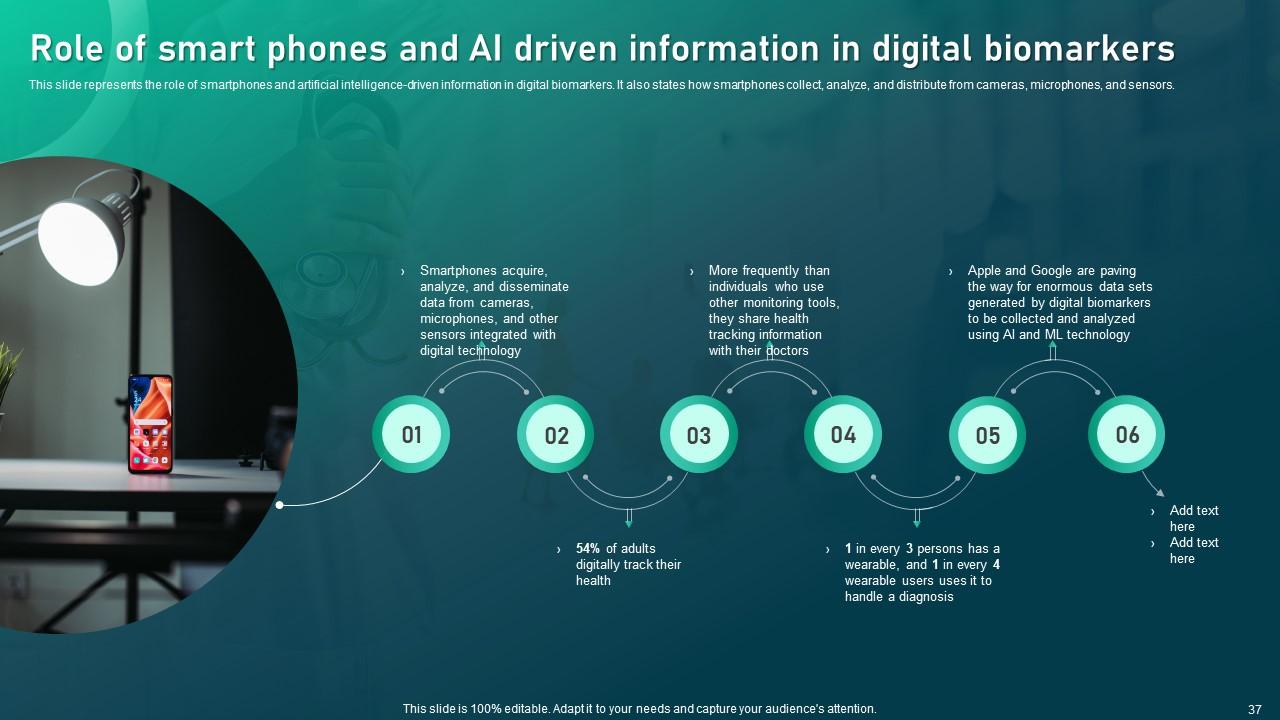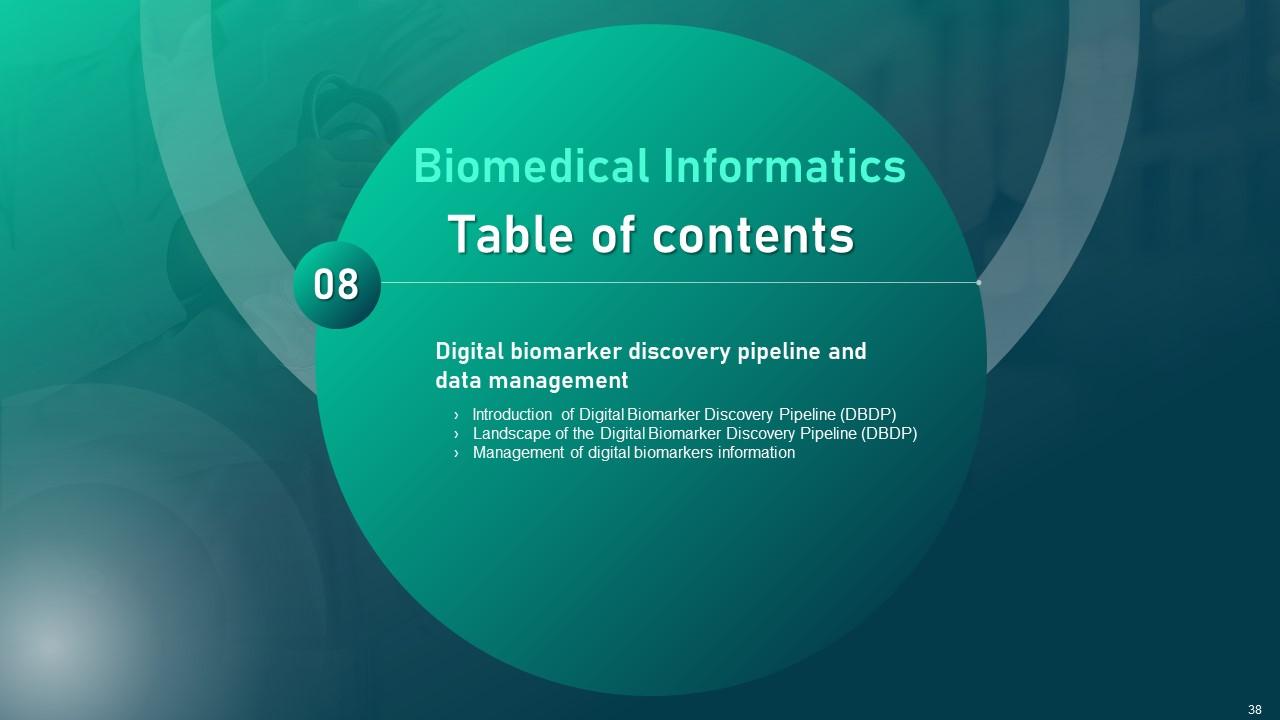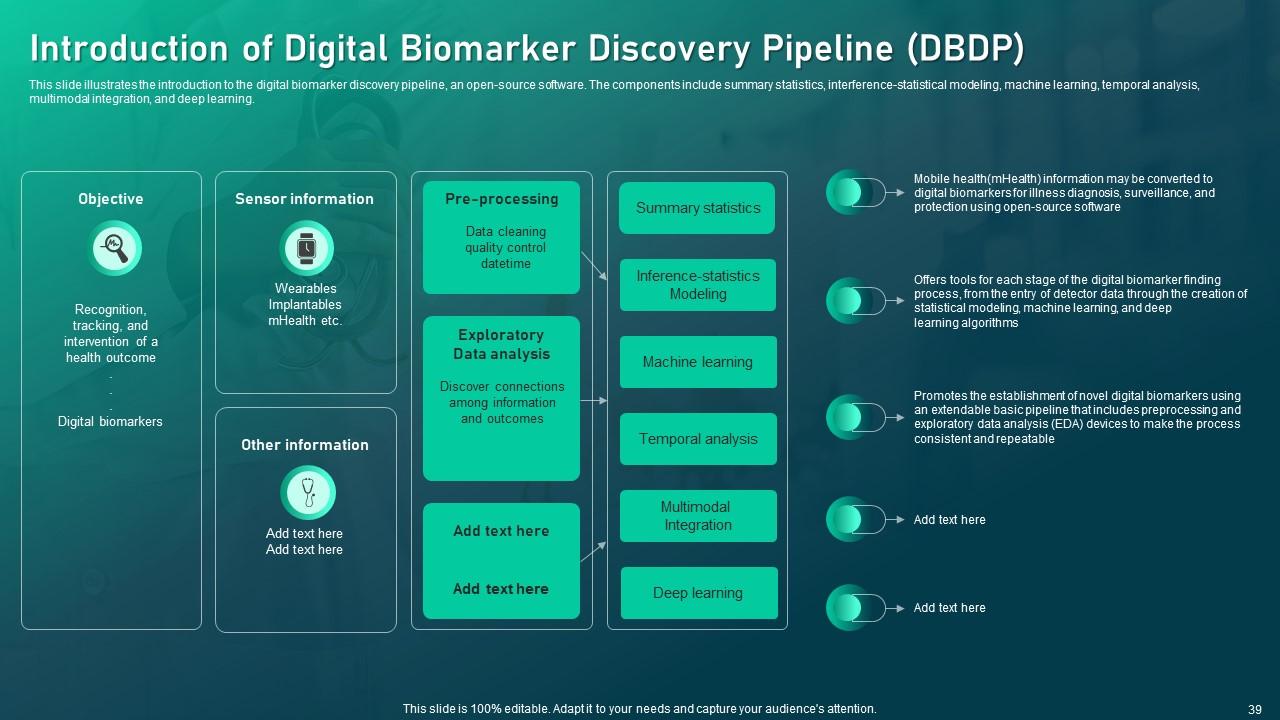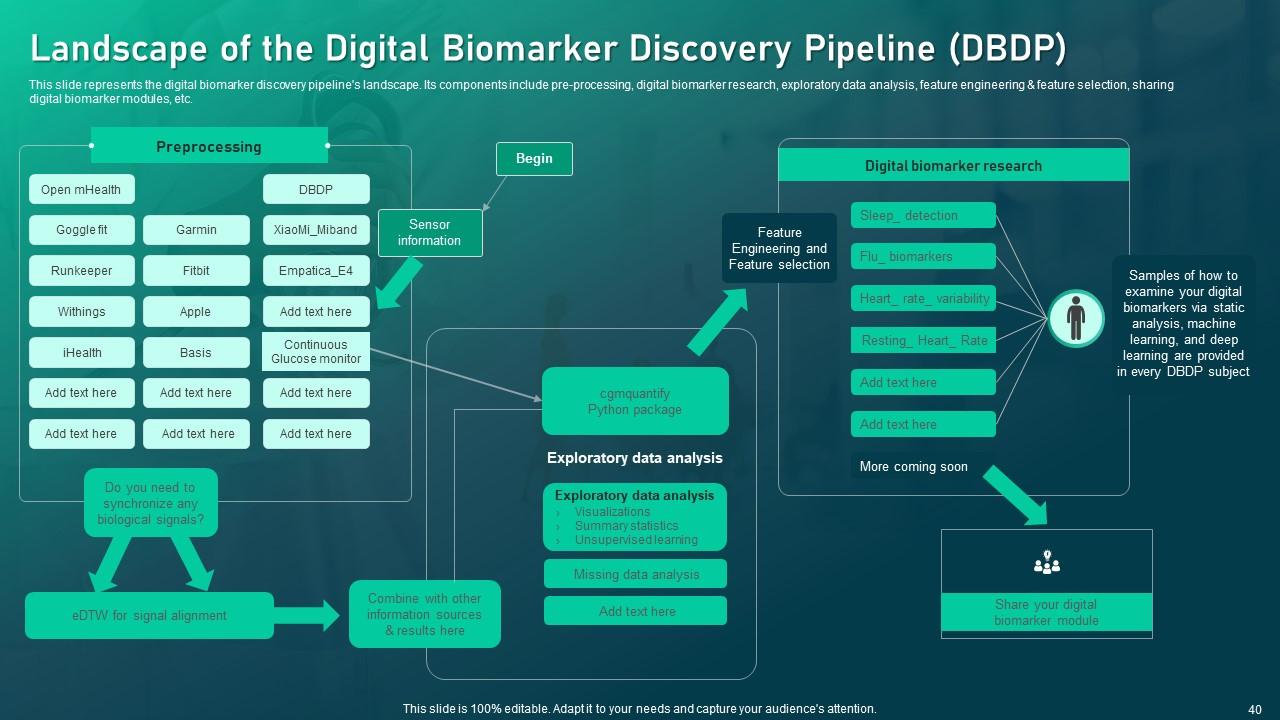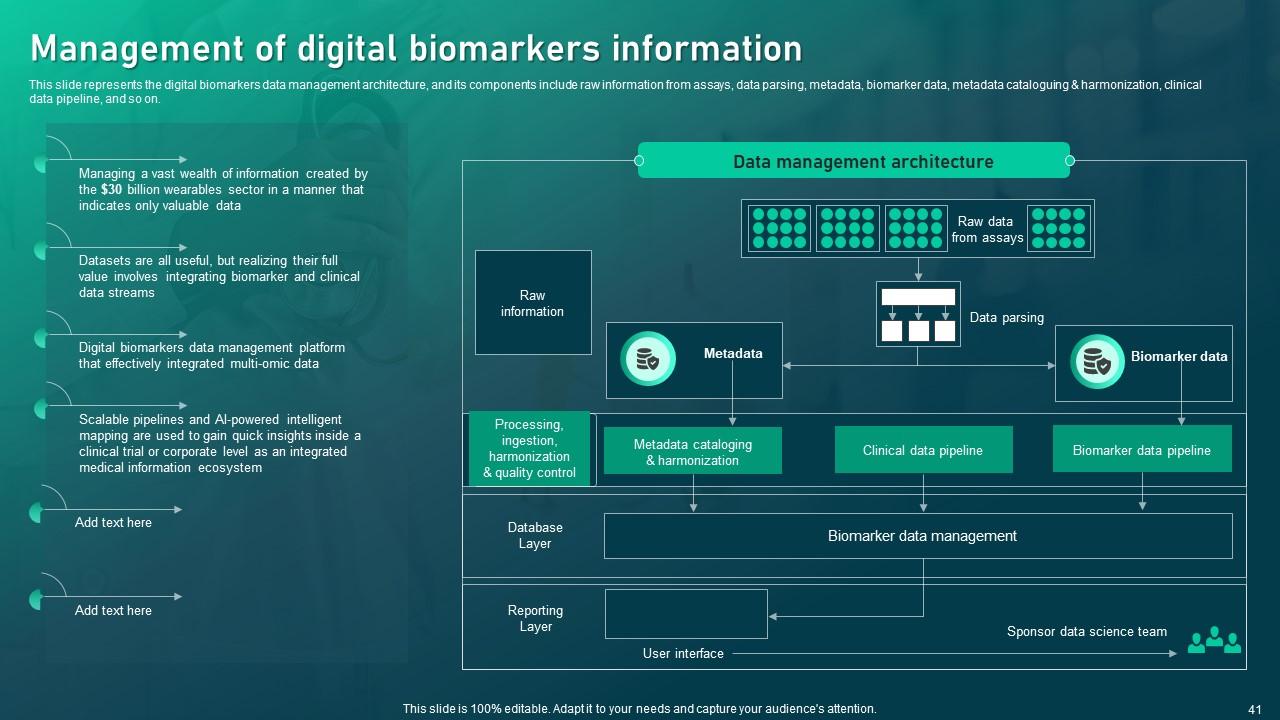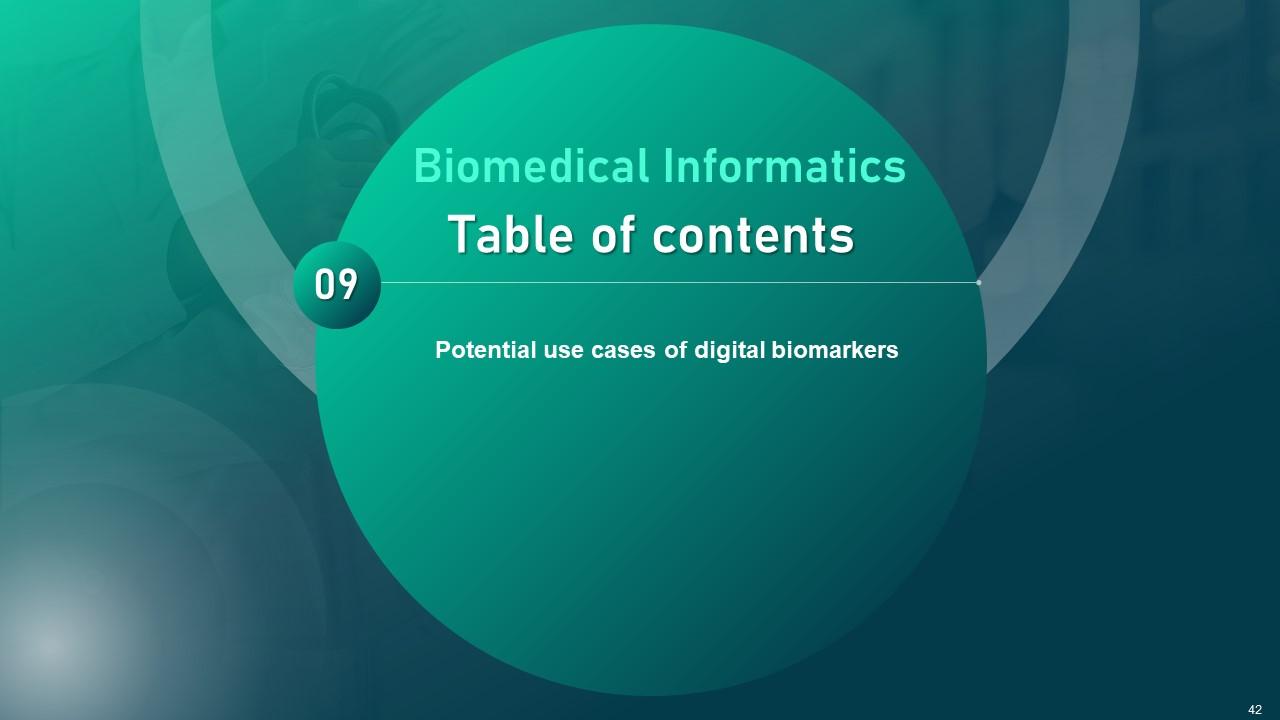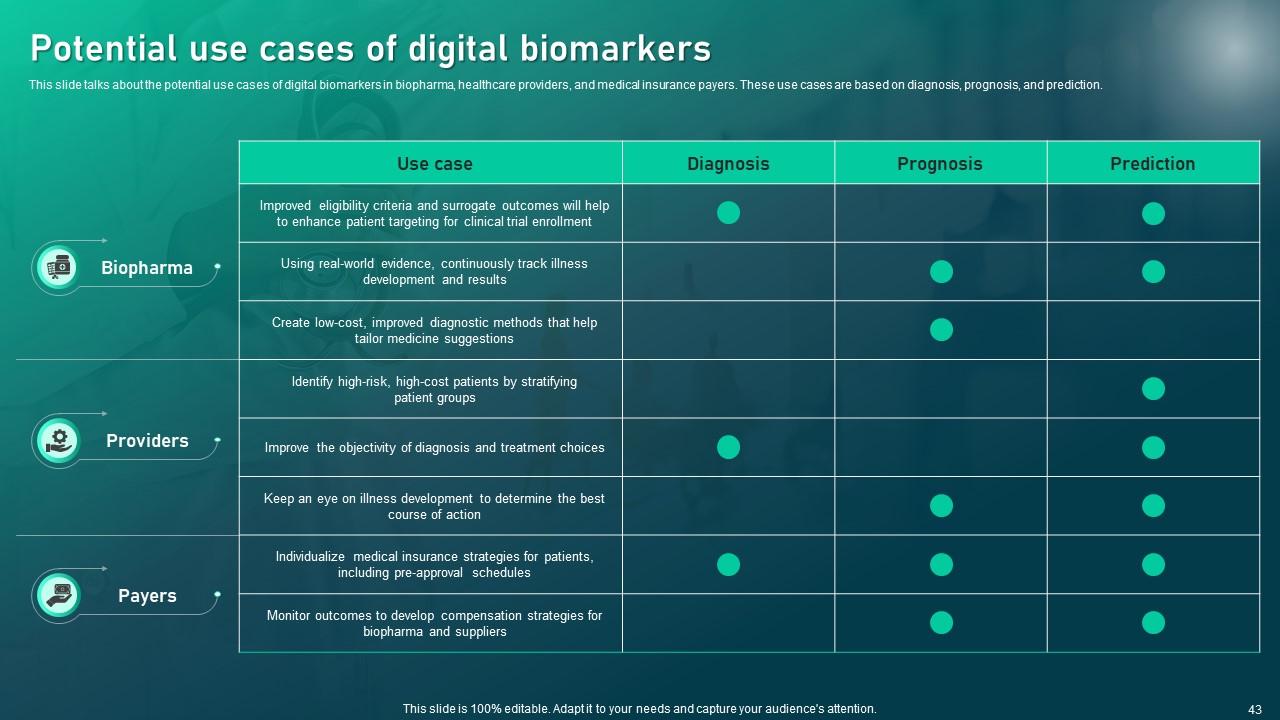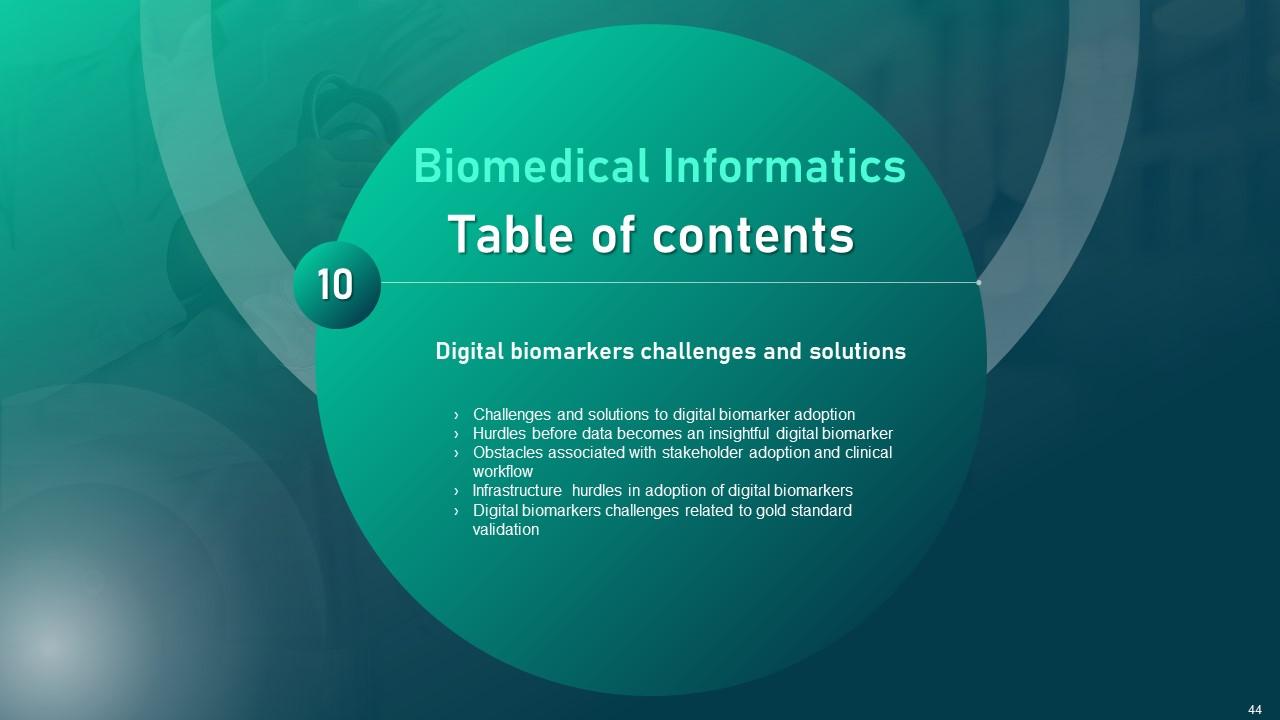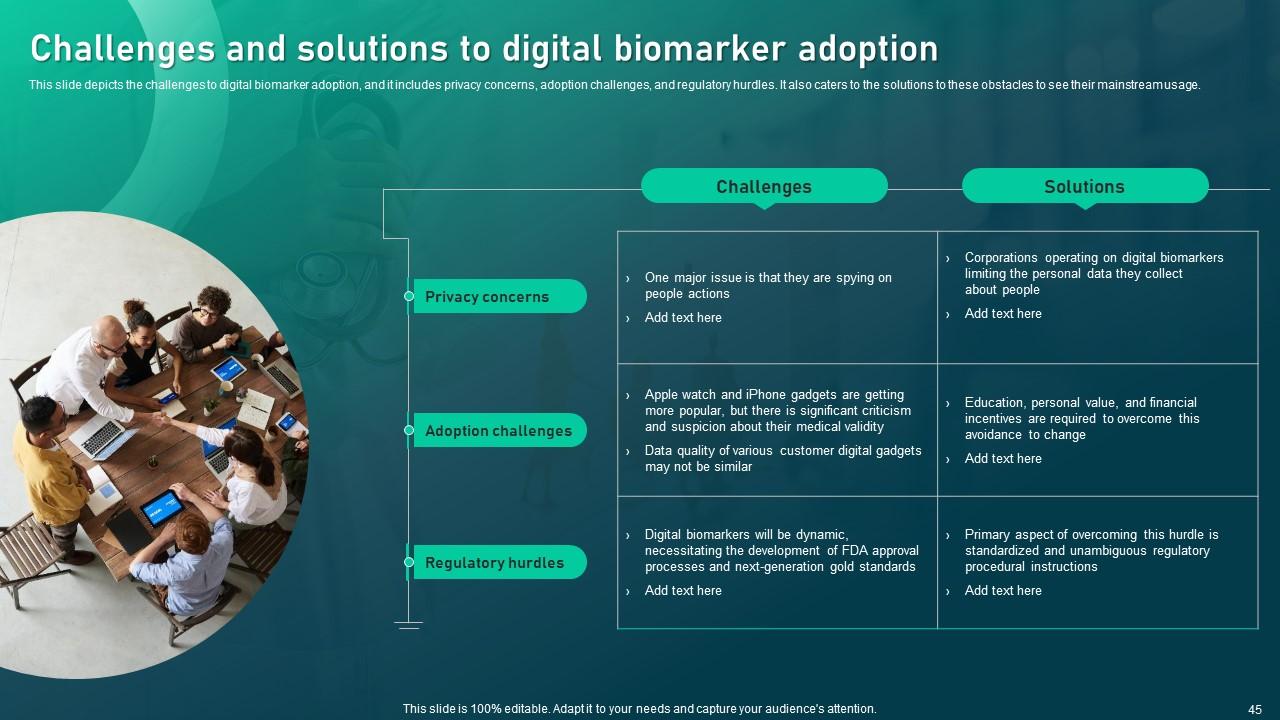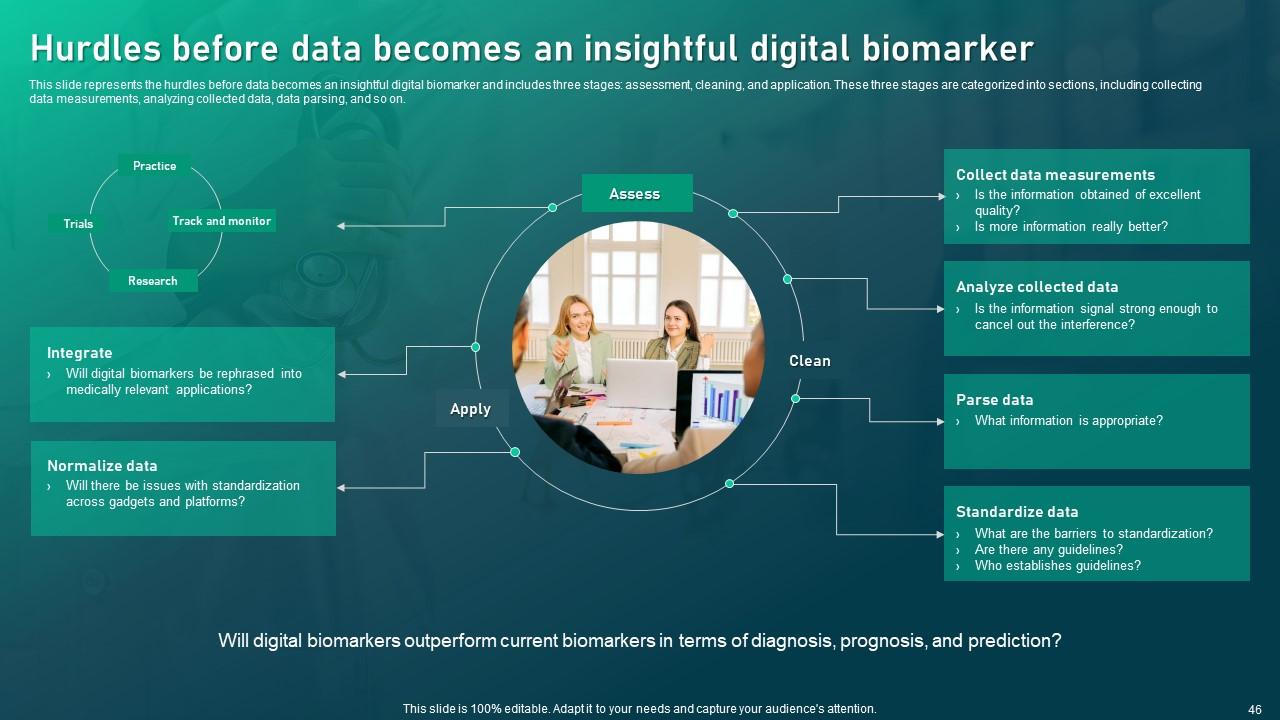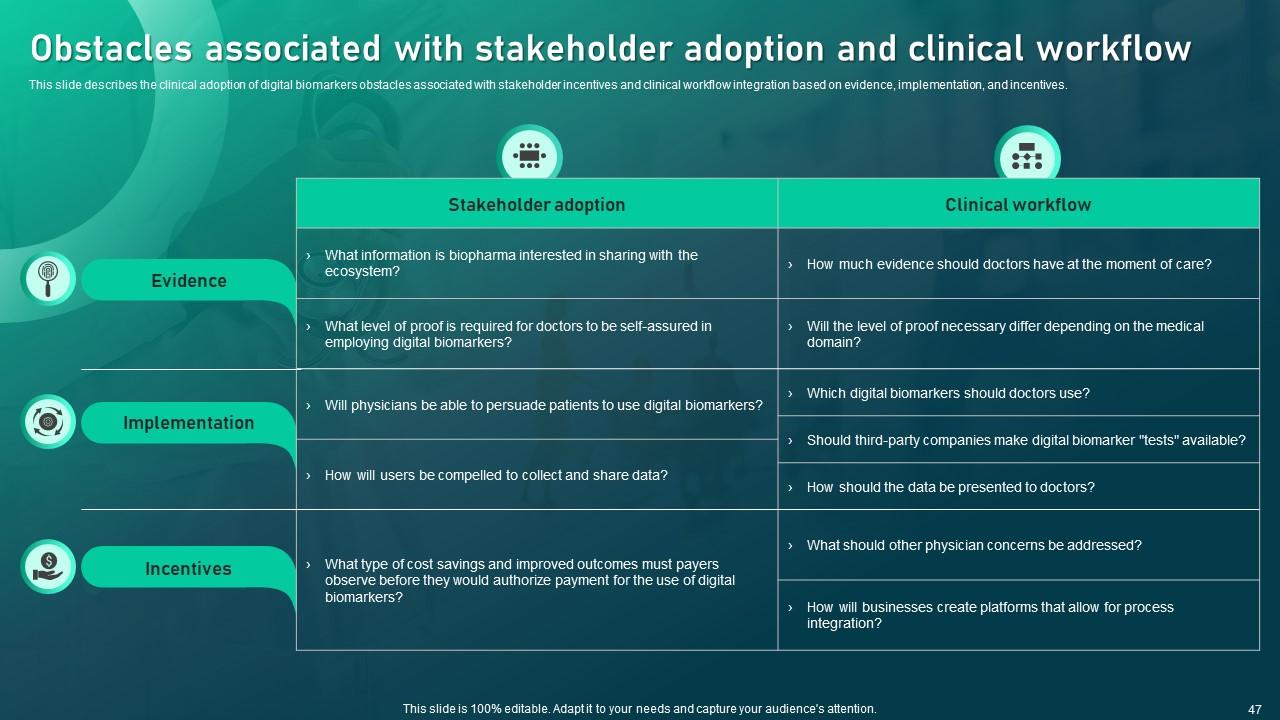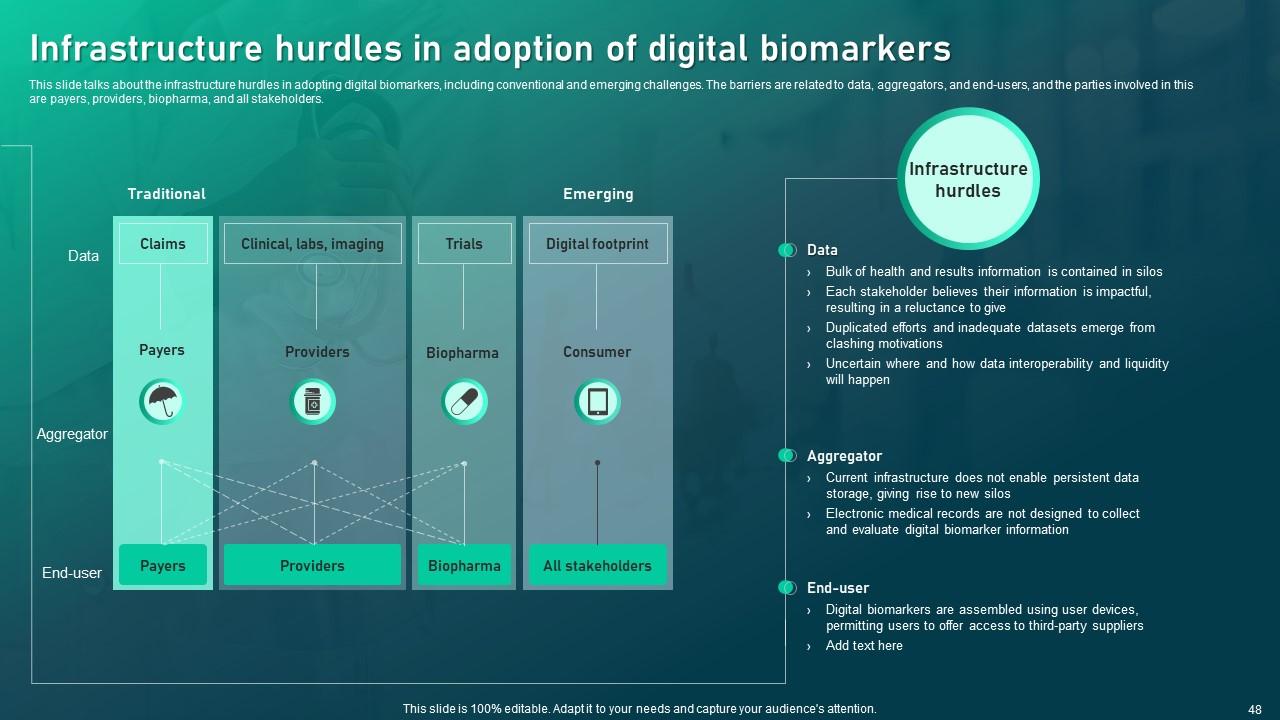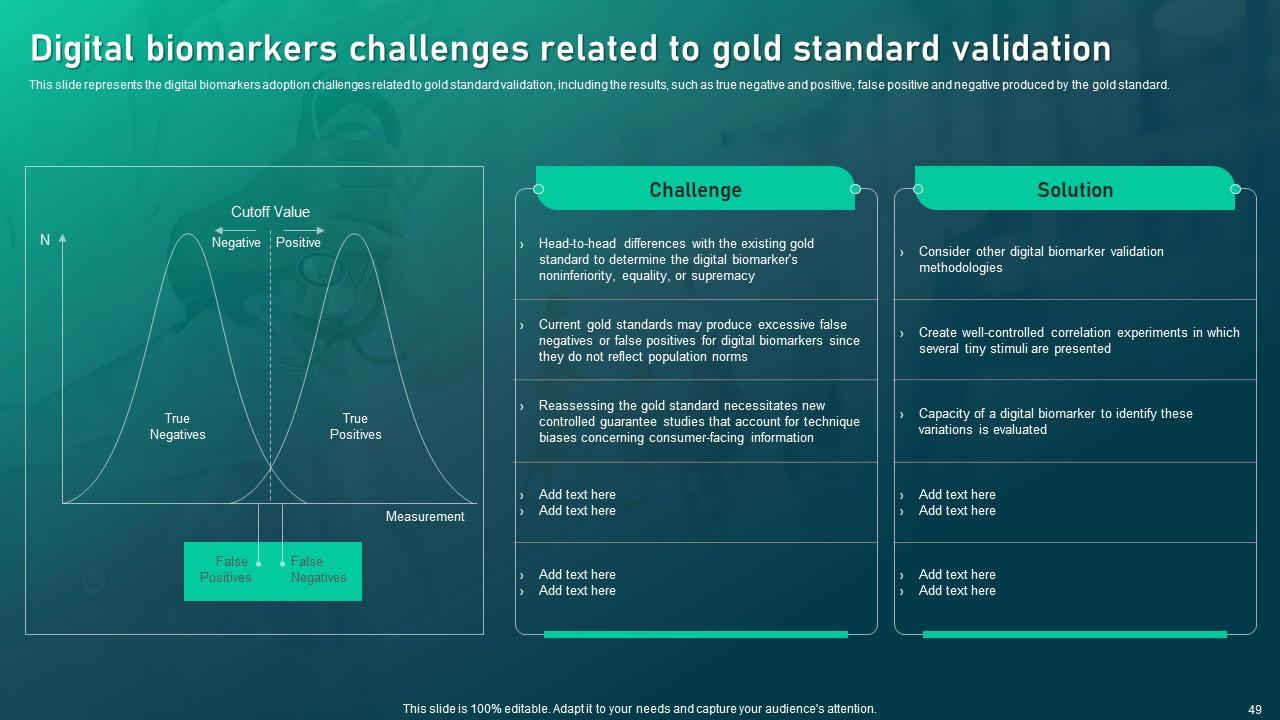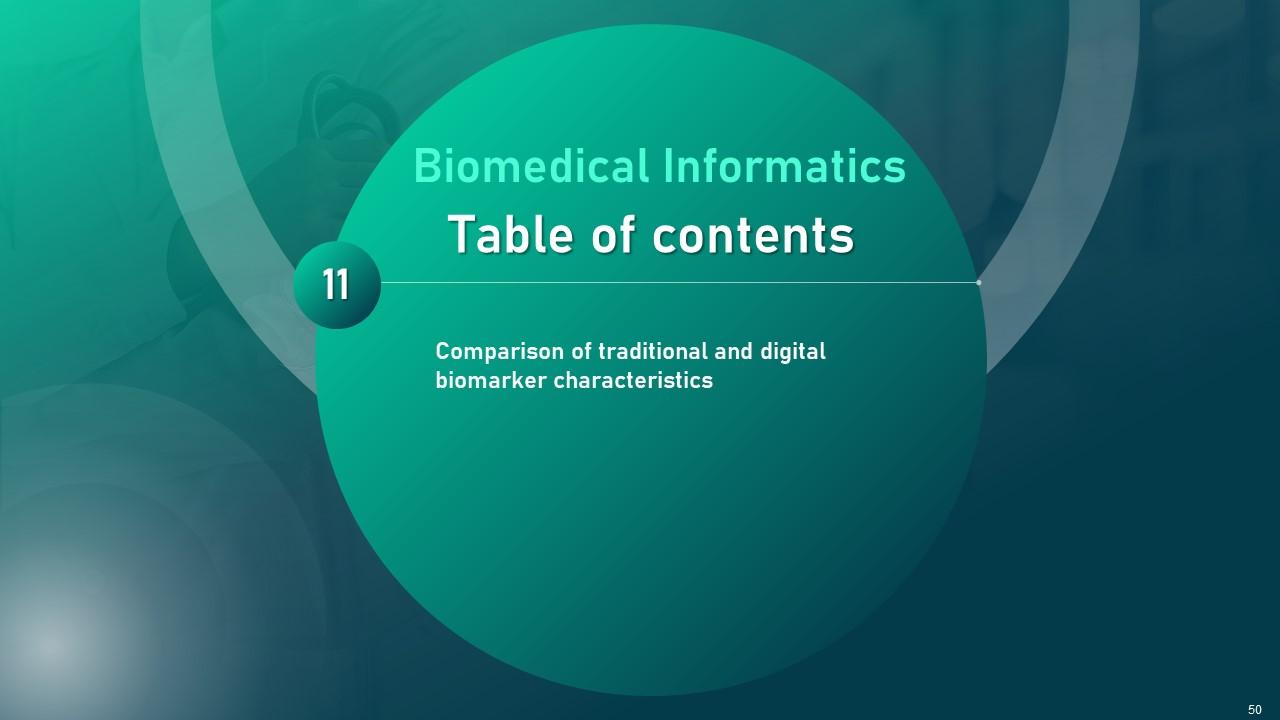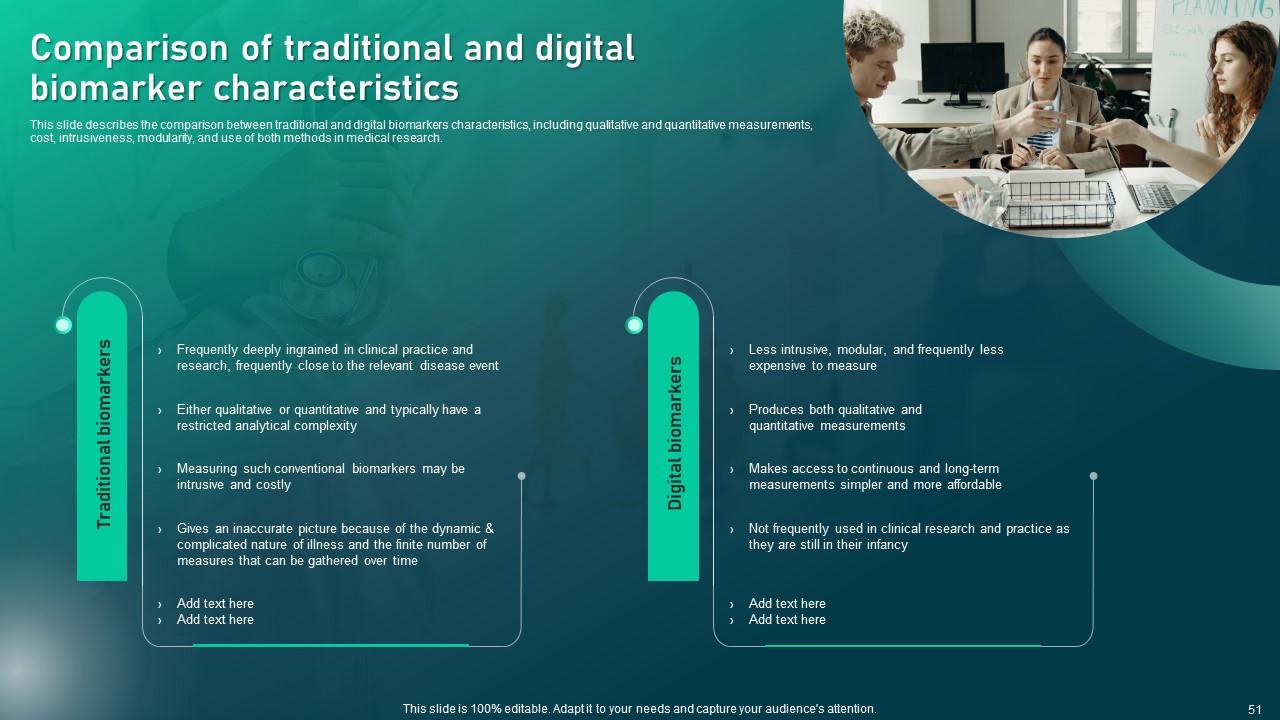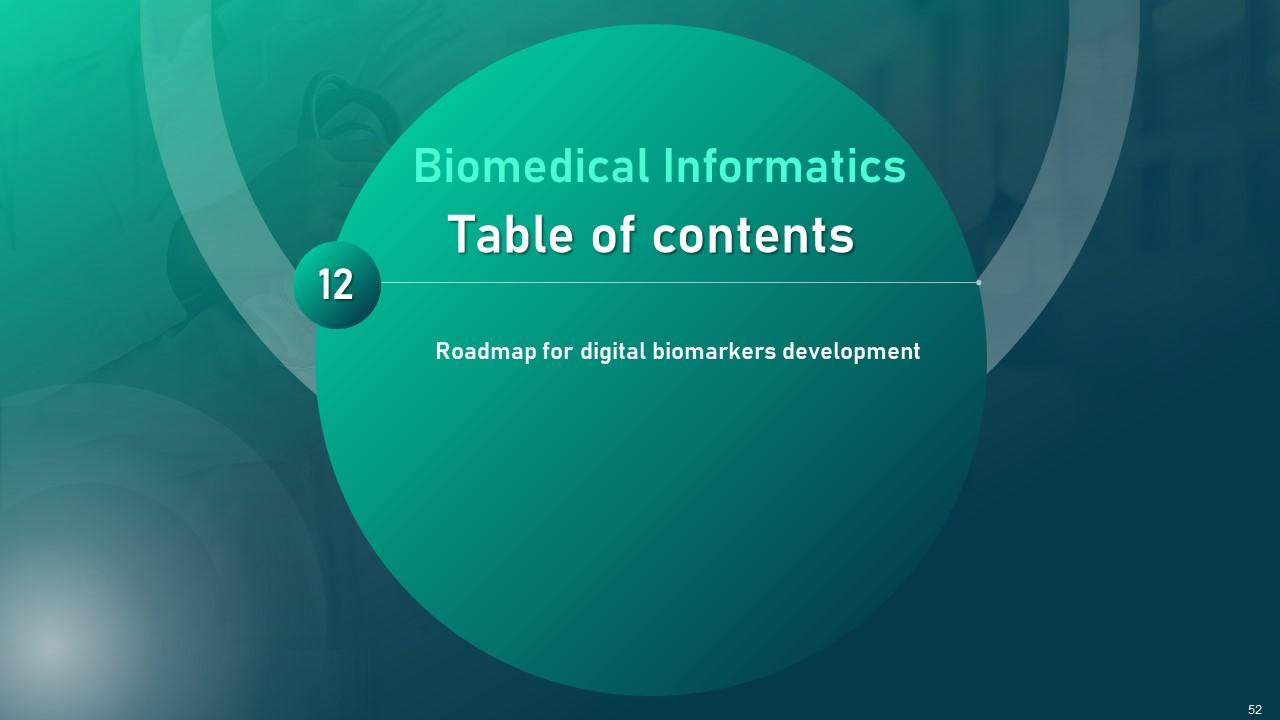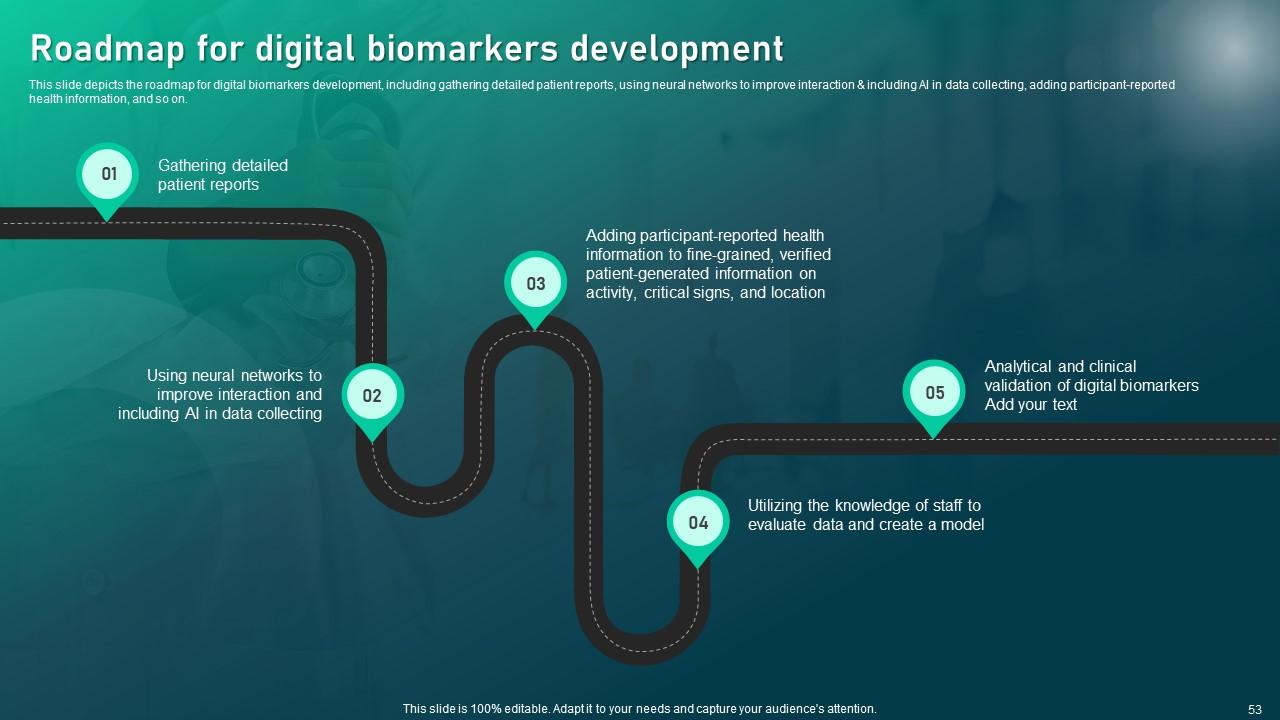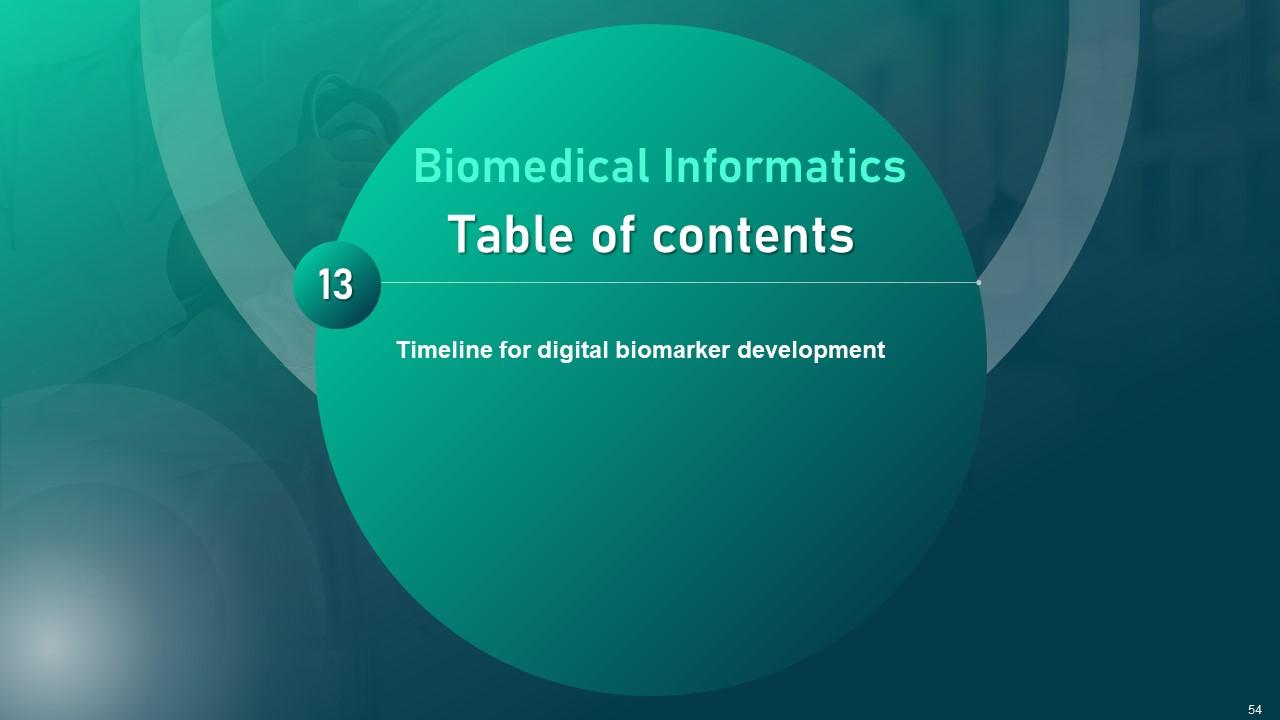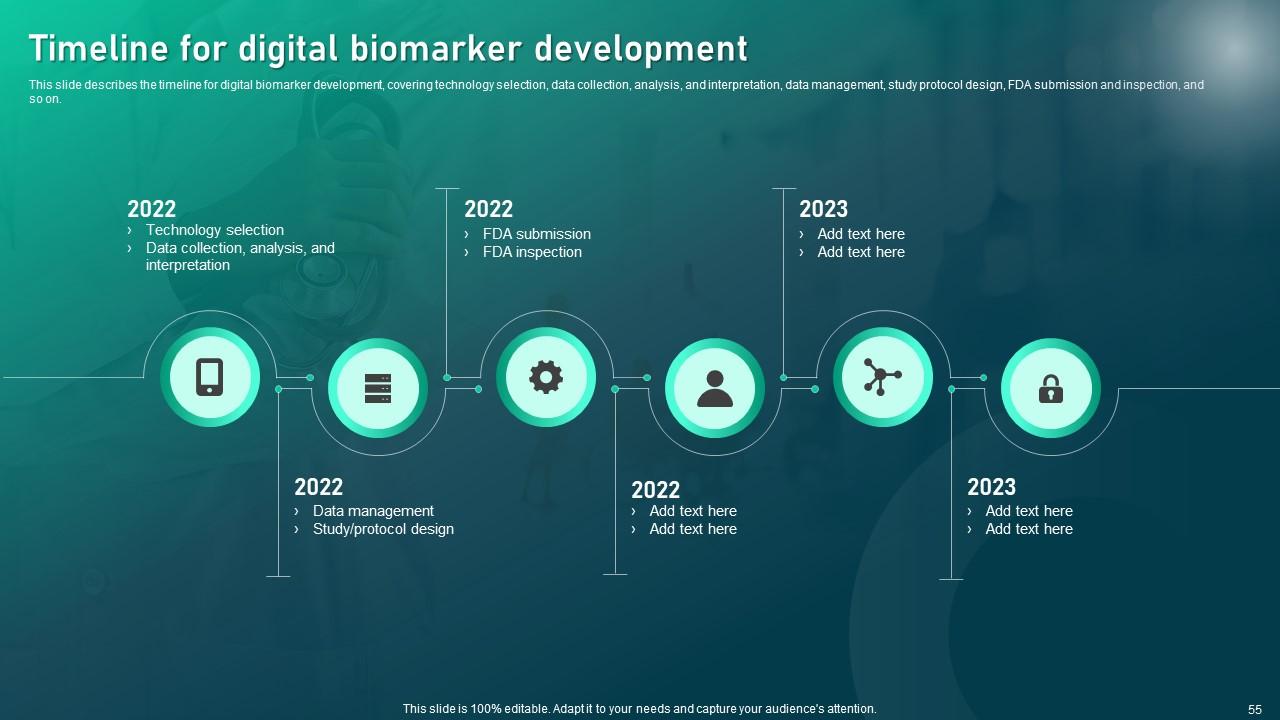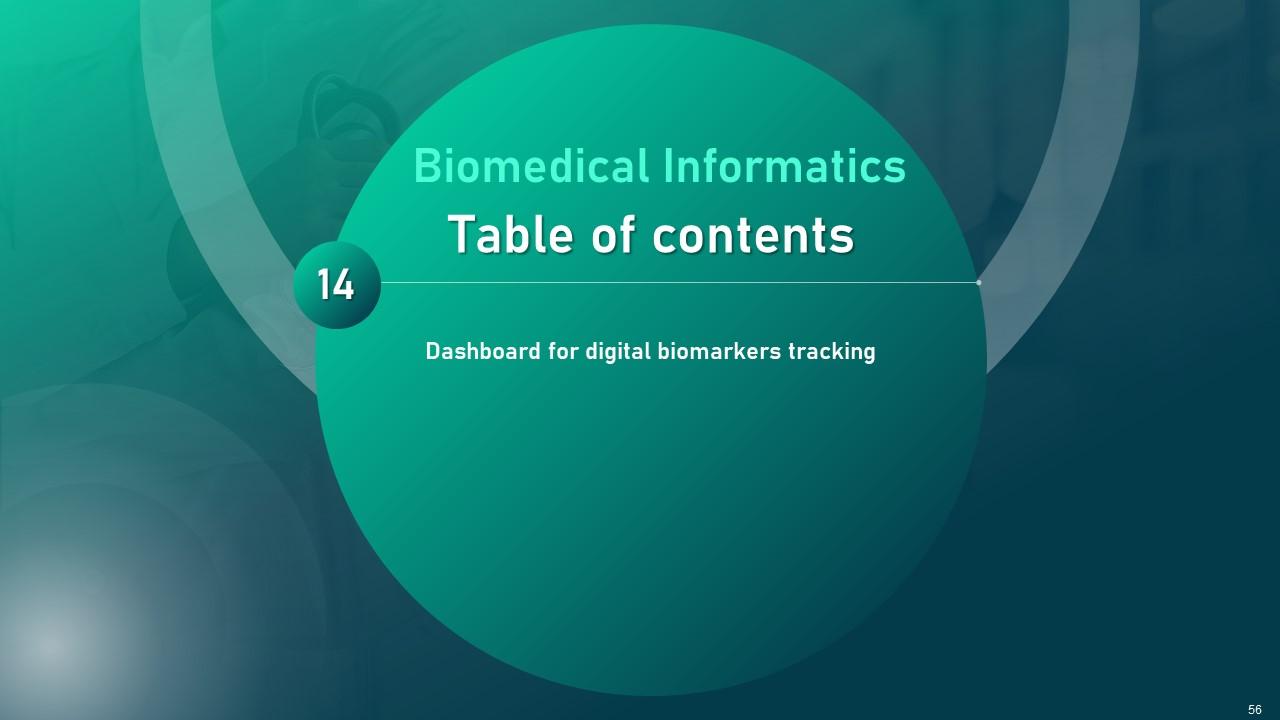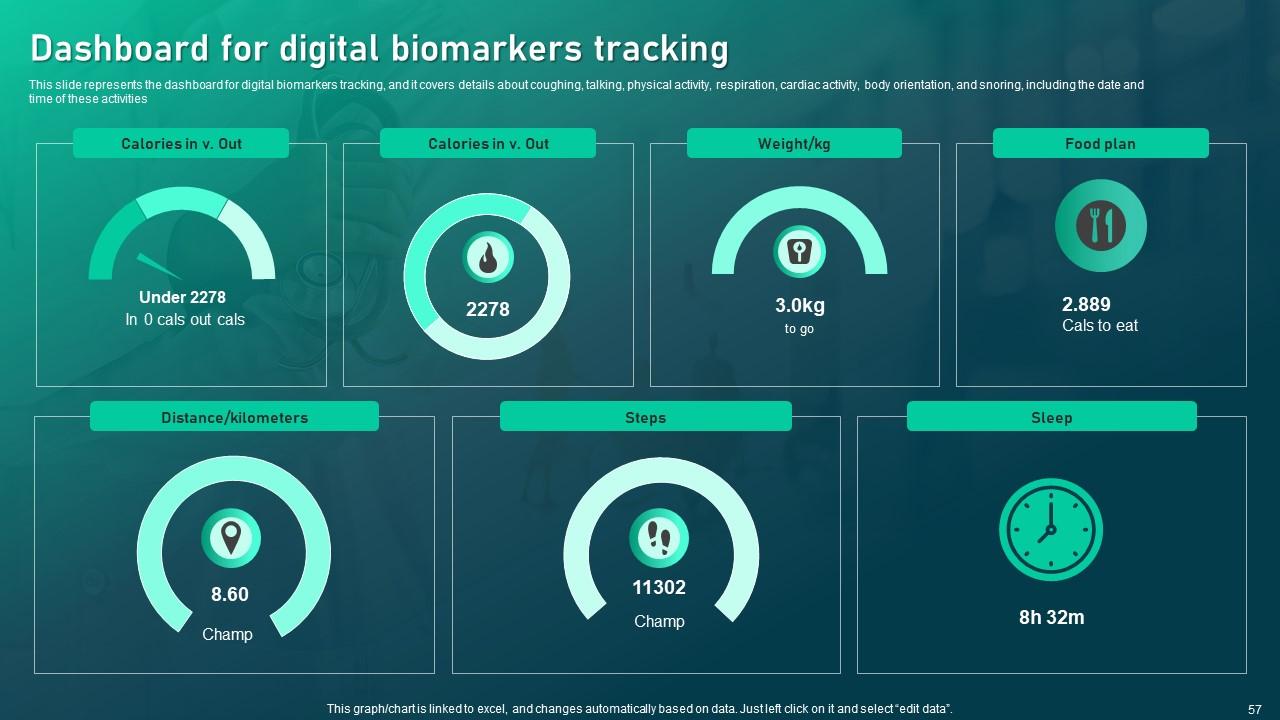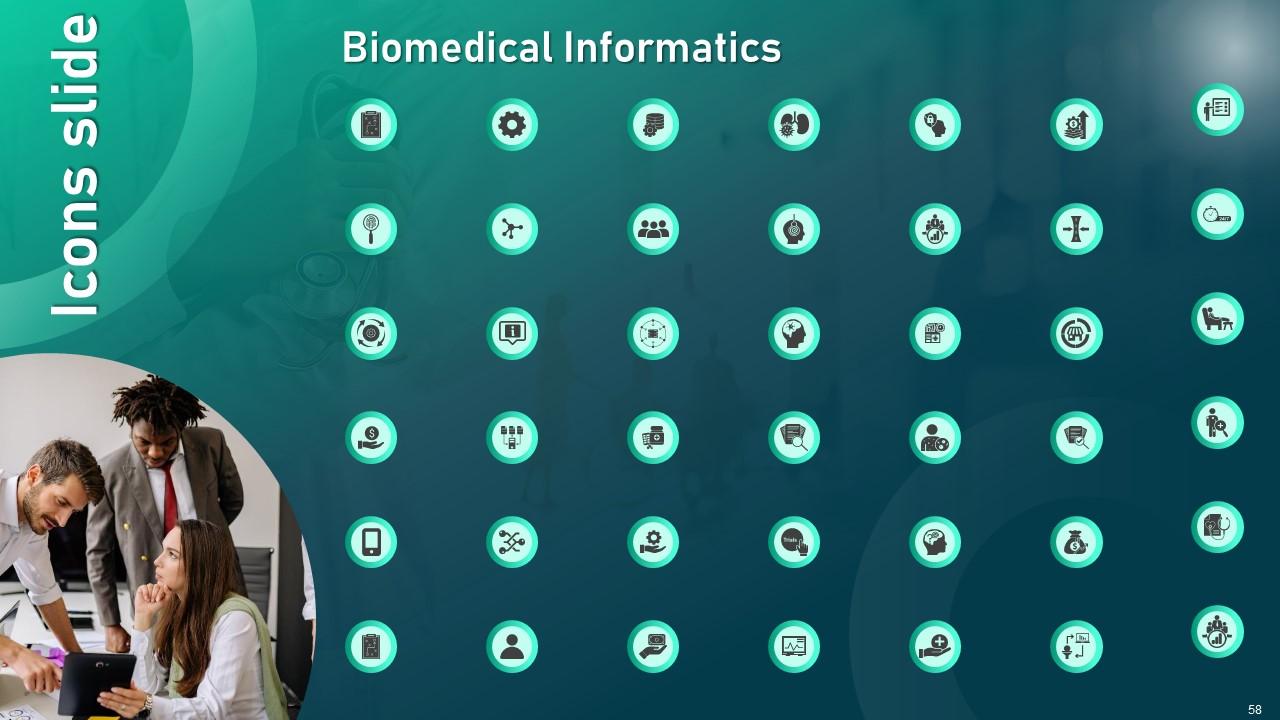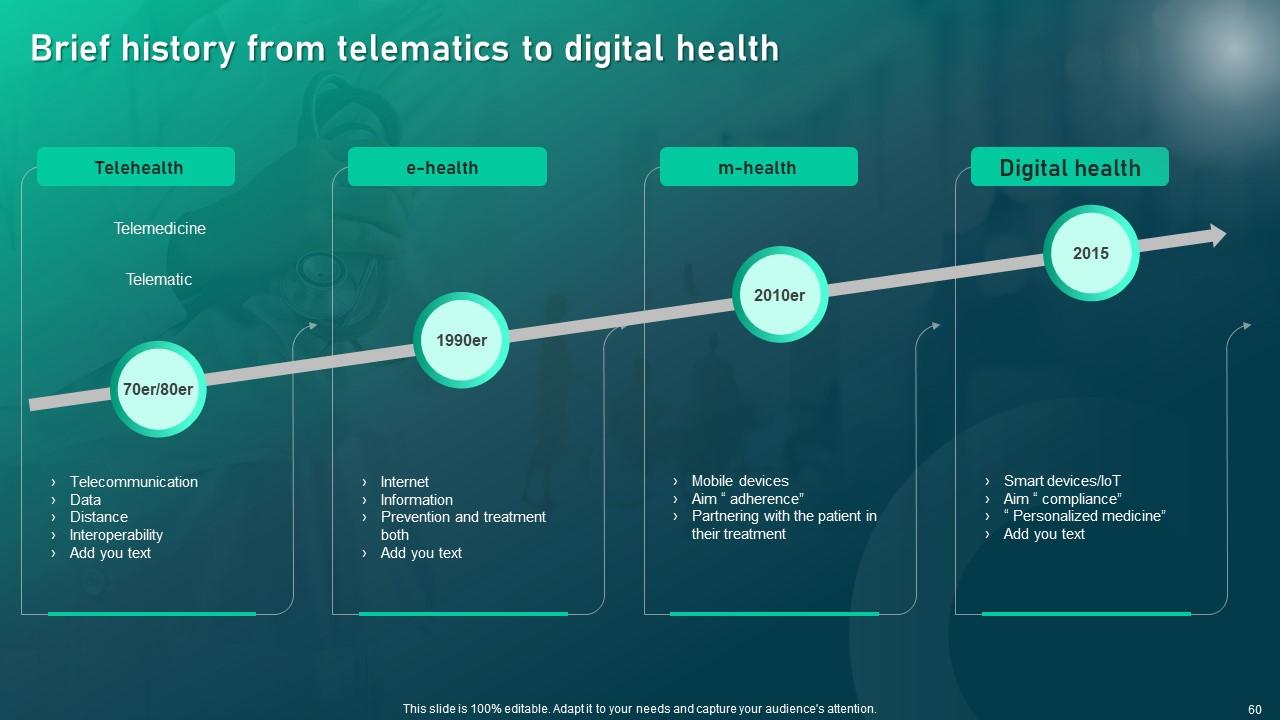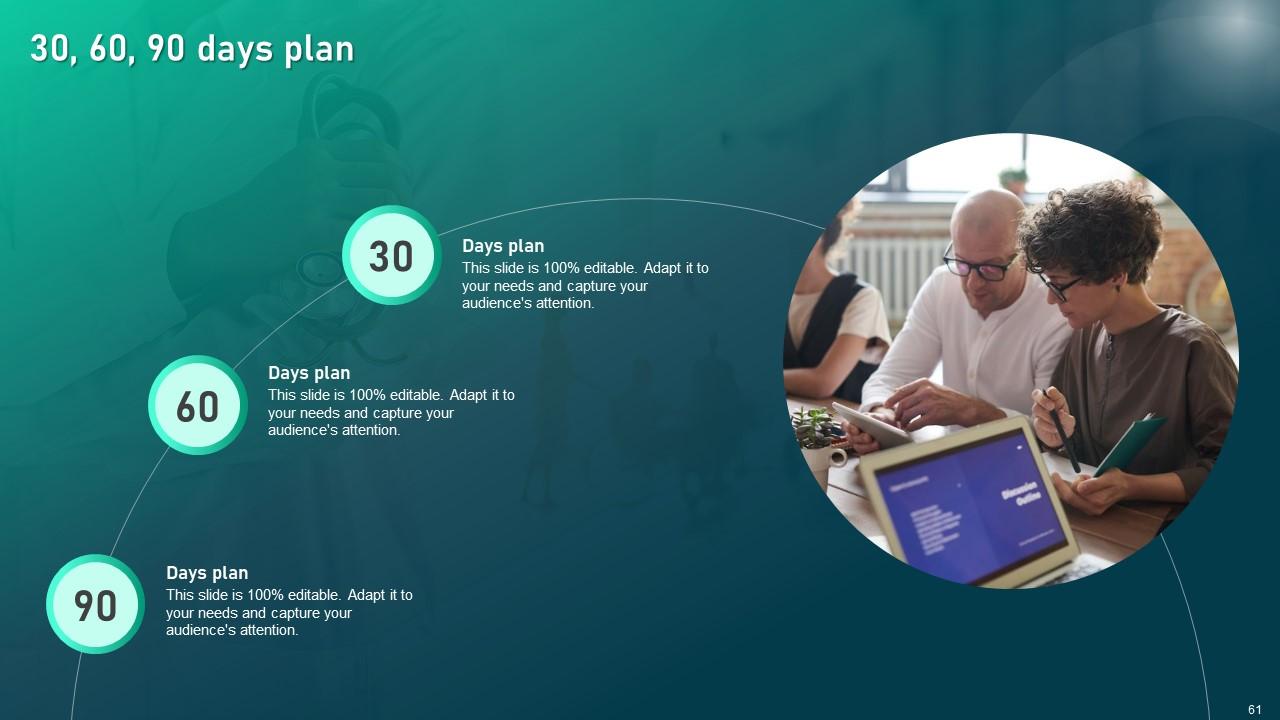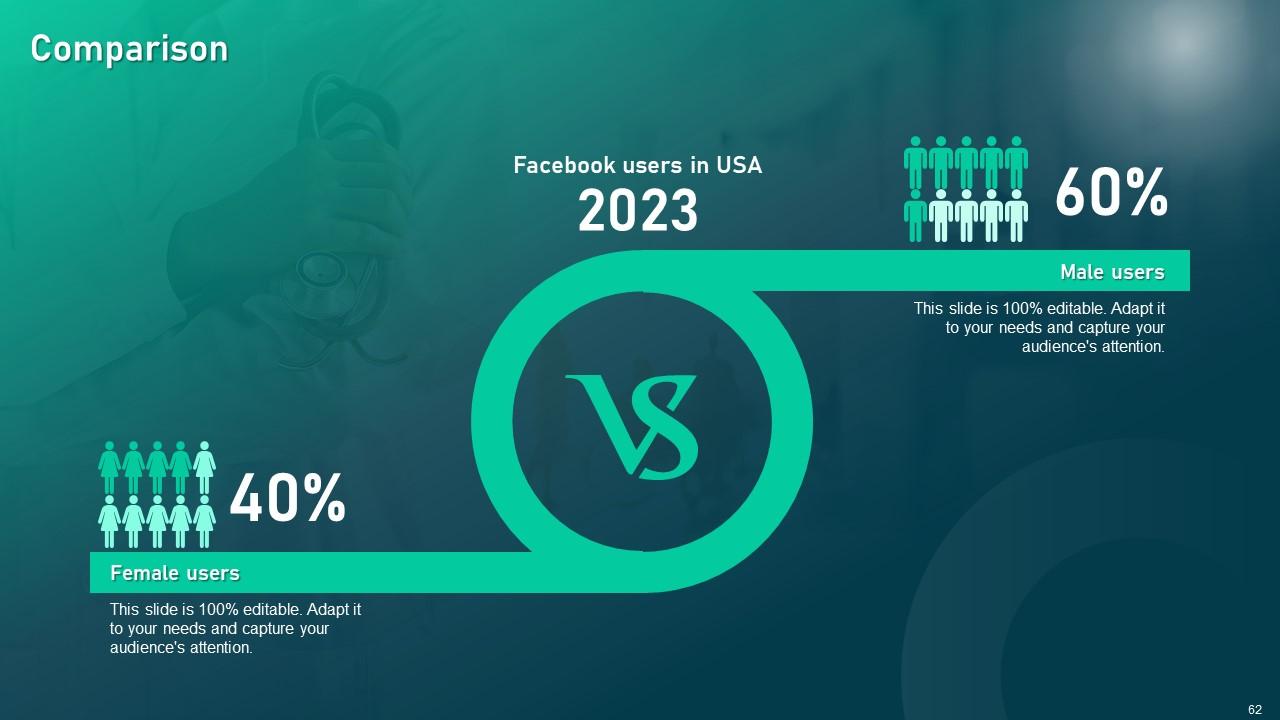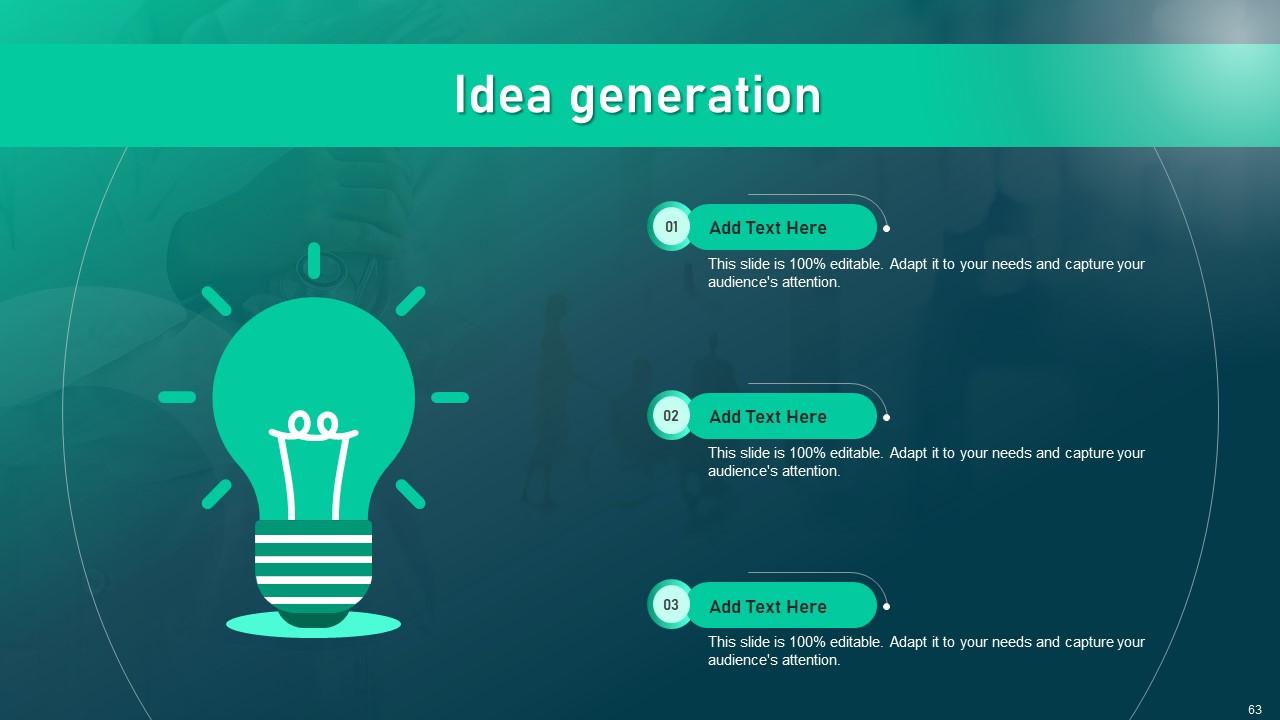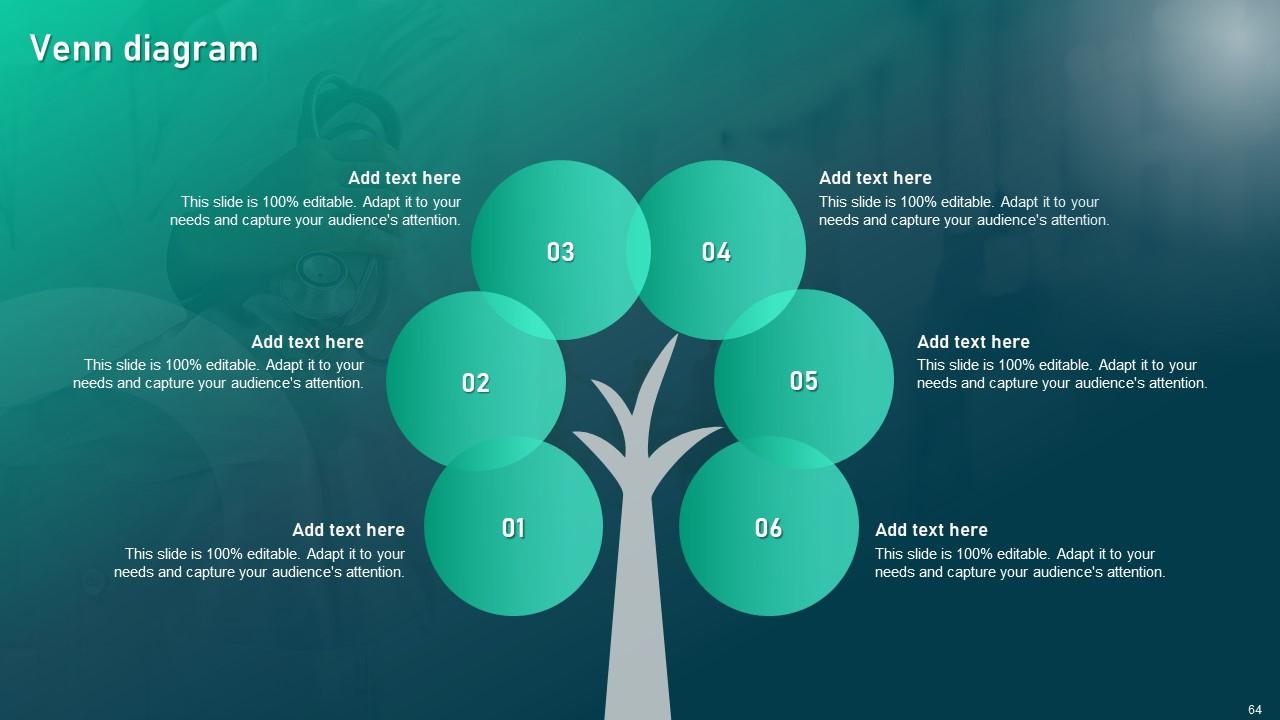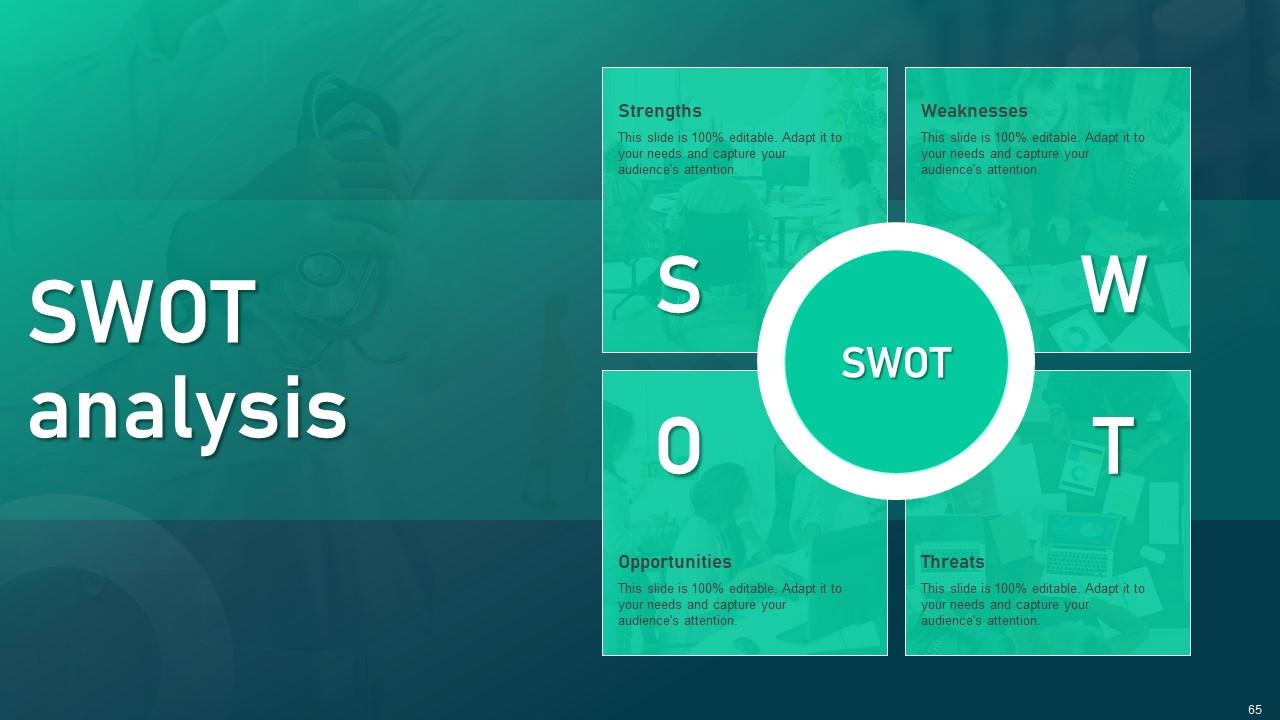Biomedical Informatics Powerpoint Presentation Slides
We had like you to take advantage of our meticulously designed Biomedical Informatics template that concisely overviews digital biomarkers. This comprehensive Biomedical Informatics presentation covers their outlook, importance, market trends, and regulatory validation processes. Also, our Digital Medicine PPT highlights the principle of behavioral analysis and the significance of Biomedical Informatics. Moreover, the biomarker classification template showcases the global market size, factors influencing the market, and regulatory validation procedures. Furthermore, the Digital Health PowerPoint explores the transformative impact of digital technology in healthcare. Additionally, the Health Information Management template explores advanced sensing technologies and devices employed in digital biomarkers, including sweat detection, insole sensing, and portable intelligent devices. Lastly, the Health Information Management PPT offers a roadmap, timeline, and performance tracking dashboard for developing digital biomarker solutions. Do not wait any longer get access to this invaluable resource now.
We had like you to take advantage of our meticulously designed Biomedical Informatics template that concisely overviews dig..
- Google Slides is a new FREE Presentation software from Google.
- All our content is 100% compatible with Google Slides.
- Just download our designs, and upload them to Google Slides and they will work automatically.
- Amaze your audience with SlideTeam and Google Slides.
-
Want Changes to This PPT Slide? Check out our Presentation Design Services
- WideScreen Aspect ratio is becoming a very popular format. When you download this product, the downloaded ZIP will contain this product in both standard and widescreen format.
-

- Some older products that we have may only be in standard format, but they can easily be converted to widescreen.
- To do this, please open the SlideTeam product in Powerpoint, and go to
- Design ( On the top bar) -> Page Setup -> and select "On-screen Show (16:9)” in the drop down for "Slides Sized for".
- The slide or theme will change to widescreen, and all graphics will adjust automatically. You can similarly convert our content to any other desired screen aspect ratio.
Compatible With Google Slides

Get This In WideScreen
You must be logged in to download this presentation.
PowerPoint presentation slides
This complete presentation has PPT slides on wide range of topics highlighting the core areas of your business needs. It has professionally designed templates with relevant visuals and subject driven content. This presentation deck has total of sixty six slides. Get access to the customizable templates. Our designers have created editable templates for your convenience. You can edit the color, text and font size as per your need. You can add or delete the content if required. You are just a click to away to have this ready-made presentation. Click the download button now.
People who downloaded this PowerPoint presentation also viewed the following :
Content of this Powerpoint Presentation
Slide 1: This slide introduces Biomedical Informatics.
Slide 2: This slide depicts the Agenda of the presentation.
Slide 3: This slide elucidates the Table of Contents.
Slide 4: This slide highlights the Title for the Topics to be covered further.
Slide 5: This slide describes the introduction to digital biomarkers that are transforming the healthcare system.
Slide 6: This slide displays the future of digital biomarkers that will create clinical measurements inconspicuous, enabling value-based treatment and potentially anticipating illnesses.
Slide 7: This slide shows the principles of behavioral analysis using digital biomarkers.
Slide 8: This slide mentions how to separate direct digital biomarkers from indirect digital biomarkers.
Slide 9: This slide elucidates the Heading for the Contents to be discussed next.
Slide 10: This slide outlines how digital biomarkers capture clinically meaningful and objective information cost-effectively.
Slide 11: This slide represents how digital biomarkers turn the evidence creation and validation process into a closed loop in case of continuous blood pressure.
Slide 12: This slide talks about how combining digital biomarkers allow for identifying phenotypic characteristics that can better explain human health and illness variation.
Slide 13: This slide potrays the Title for the Ideas to be covered further.
Slide 14: This slide represents the global market size of the digital biomarkers from the year 2022 to 2028.
Slide 15: This slide deals with the factors affecting the digital biomarkers market.
Slide 16: This slide outlines the market segmentation for digital biomarkers including sleep and movement, cardiovascular, mood and behavior, pain management, etc.
Slide 17: This slide contains the Heading for the Topics to be discussed next.
Slide 18: This slide represents the process of regulatory validation for digital biomarkers with known measurements and known insights and novel measurements and novel insights.
Slide 19: This slide indicates the features of precision neurology technology which is a new gold standard.
Slide 20: This slide highlights the Title for the Components to be discussed further.
Slide 21: This slide illustrates the advantages of digital biomarkers in healthcare based on cost, digital conversions, comfort, etc. for continuous monitoring to provide a more accurate assessment of consumer health.
Slide 22: This slide represents how digital biomarkers are transforming the healthcare system by aiding in early illness detection, treatment effectiveness evaluation, resolving clinical trial recruiting challenges, etc.
Slide 23: This slide describes the impact of digital biomarkers on neurology and psychiatry, including how with the help of digital healthcare devices it can help to detect diseases that do not have particular conventional biomarker tests.
Slide 24: This slide depicts the current applications of digital biomarkers in different domains of the healthcare sector.
Slide 25: This slide displays the Heading for the Ideas to be covered in the upcoming template.
Slide 26: This slide represents the categorization of digital biomarkers in the healthcare system, including approved, original, and novel.
Slide 27: This is yet another slide continuing the Categorization of healthcare digital biomarkers.
Slide 28: This slide outlines how digital biomarker users come from a wide range of backgrounds and are divided into three groups.
Slide 29: This slide outlines how digital biomarkers will expand and amplify the user's role, and it includes digital tools such as activity sensors and parameter-specific biosensors.
Slide 30: This slide indicates the Title for the Topics to be covered further.
Slide 31: This slide depicts the enhanced sensing technologies such as sweat detection that examine biomarkers extracted from a person’s sweat.
Slide 32: This slide outlines the insole advanced sensing technologies, such as digital pedometer and step counters.
Slide 33: This slide talks about the advanced sensing technology apps for early predictions of diseases such as alzheimer’s and mental health disorders.
Slide 34: This slide showcases the portable devices used for digital biomarkers and some major players in the industry.
Slide 35: This slide represents the use of data analytics to detect and track diseases through sensors, such as accelerometers, gyroscopes, and pedometers.
Slide 36: This slide illustrates the role of smartphones and artificial intelligence-driven information in digital biomarkers.
Slide 37: This slide mentions the Heading for the Contents to be discussed in the forth-coming template.
Slide 38: This slide illustrates the introduction to the digital biomarker discovery pipeline, an open-source software.
Slide 39: This slide represents the digital biomarker discovery pipeline's landscape.
Slide 40: This slide highlights the digital biomarkers data management architecture, and its components include raw information from assays, data parsing, metadata, etc.
Slide 41: This slide comprises the Heading for the Ideas to be discussed in the next template.
Slide 42: This slide talks about the potential use cases of digital biomarkers in biopharma, healthcare providers, and medical insurance payers.
Slide 43: This slide mentions the Title for the Topics to be covered further.
Slide 44: This slide depicts the challenges to digital biomarker adoption, and it includes privacy concerns, adoption challenges, and regulatory hurdles.
Slide 45: This slide represents the hurdles before data becomes an insightful digital biomarker and includes three stages: assessment, cleaning, and application.
Slide 46: This slide describes the clinical adoption of digital biomarkers obstacles associated with stakeholder incentives and clinical workflow integration based on evidence, implementation, and incentives.
Slide 47: This slide talks about the infrastructure hurdles in adopting digital biomarkers, including conventional and emerging challenges.
Slide 48: This slide represents the digital biomarkers adoption challenges related to gold standard validation, including the results, such as true negative and positive, false positive and negative produced by the gold standard.
Slide 49: This slide elucidates the Heading for the Ideas to be discussed further.
Slide 50: This slide describes the comparison between traditional and digital biomarkers characteristics, including qualitative and quantitative measurements, cost, intrusiveness, modularity, and use of both methods in medical research.
Slide 51: This slide exhibits the Title for the Components to be covered in the following template.
Slide 52: This slide depicts the roadmap for digital biomarkers development, including gathering detailed patient reports, using neural networks to improve interaction.
Slide 53: This slide potrays the Heading for the Topics to be discussed next.
Slide 54: This slide describes the timeline for digital biomarker development, covering technology selection, data collection, analysis, and interpretation, etc.
Slide 55: This slide highlights the Title for the Topics to be covered further.
Slide 56: This slide represents the dashboard for digital biomarkers tracking, and it covers details about coughing, talking, physical activity, respiration, cardiac activity, etc.
Slide 57: This is the Icons slide containing all the Icons used in the plan.
Slide 58: This slide is used to reveal some Additional information.
Slide 59: This slide mentions about the Brief history from telematics to digital health.
Slide 60: This slide presents the Stacked column for depicting company related information.
Slide 61: This is the Line chart for some relevant information.
Slide 62: This slide potrays the Organization's Timeline.
Slide 63: This is the Puzzle slide with related imagery.
Slide 64: This slide includes the Post it notes for reminders and deadlines.
Slide 65: This slide incorporates the 30 60 90 days plan for efficient planning.
Slide 66: This is the Venn diagram slide for some more relevant information.
Slide 67: This is the Thank You slide for acknowledgement.
Biomedical Informatics Powerpoint Presentation Slides with all 71 slides:
Use our Biomedical Informatics Powerpoint Presentation Slides to effectively help you save your valuable time. They are readymade to fit into any presentation structure.
FAQs
Digital biomarkers are objective, quantifiable measures obtained from digital devices and sensors that provide clinically meaningful information about an individual's health and well-being. They can be used to monitor and track various physiological, behavioral, and environmental parameters.
Digital biomarkers are transforming the healthcare system by enabling continuous monitoring of patients, providing real-time and objective data for diagnosis and treatment decisions, improving disease management and personalized care, and facilitating remote patient monitoring and telemedicine.
Digital biomarkers can be categorized into physiological biomarkers (e.g., heart rate, blood pressure), behavioral biomarkers (e.g., sleep patterns, activity levels), and environmental biomarkers (e.g., air quality, noise levels) based on the parameters they measure.
The advantages of digital biomarkers in healthcare include cost-effectiveness, continuous monitoring, real-time data collection, early detection of diseases, personalized treatment plans, improved patient engagement, and enhanced research and development capabilities.
Some challenges to adopting digital biomarkers include stakeholder incentives, data management, and privacy concerns, regulatory and validation requirements, integration with existing healthcare systems, infrastructure limitations, and the need for standardized protocols and interoperability.
-
One word for SlideTeam–Versatile!
-
Fantastic collection of visually appealing PowerPoint templates. They certainly uplift the look of the presentation.


